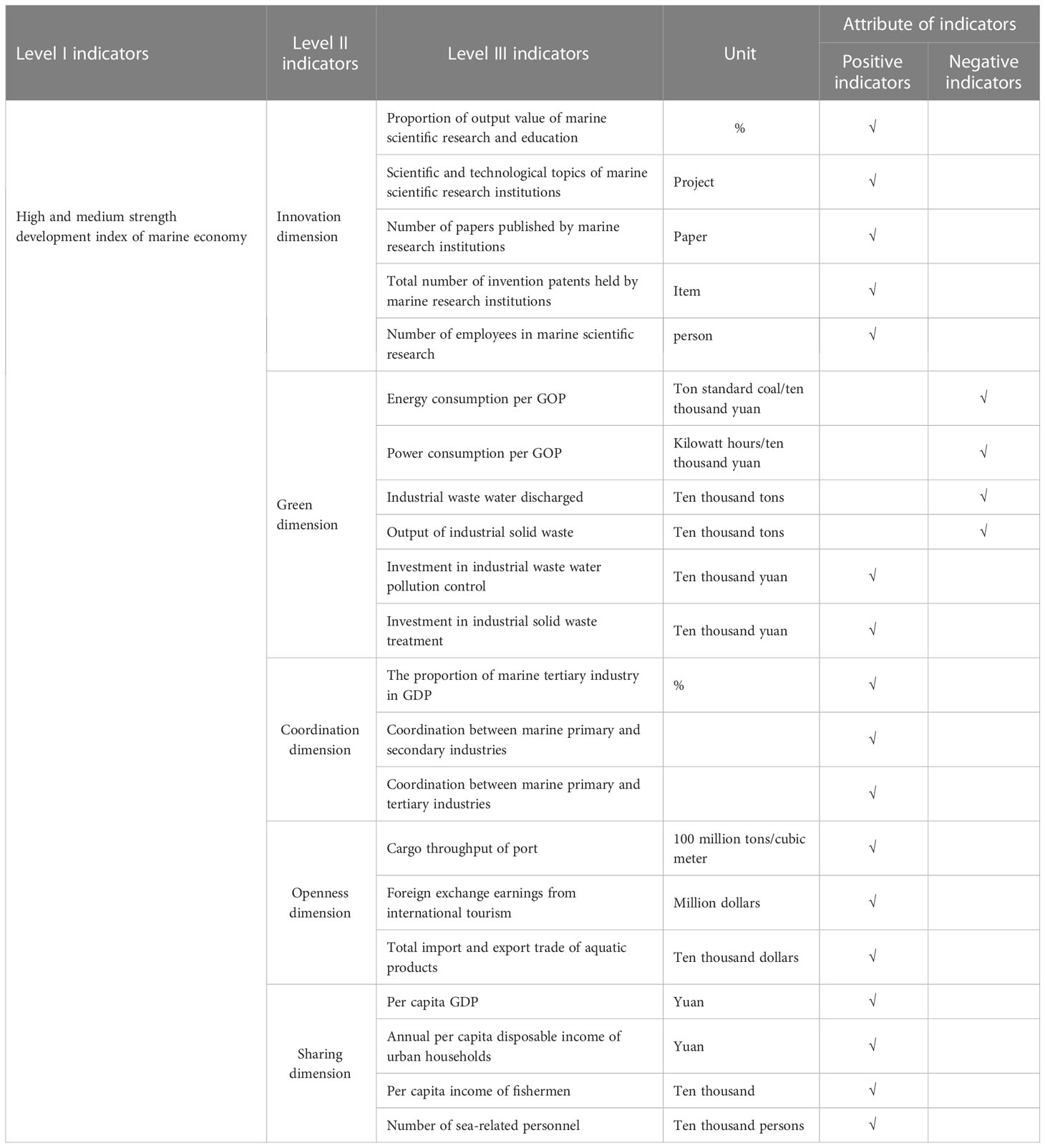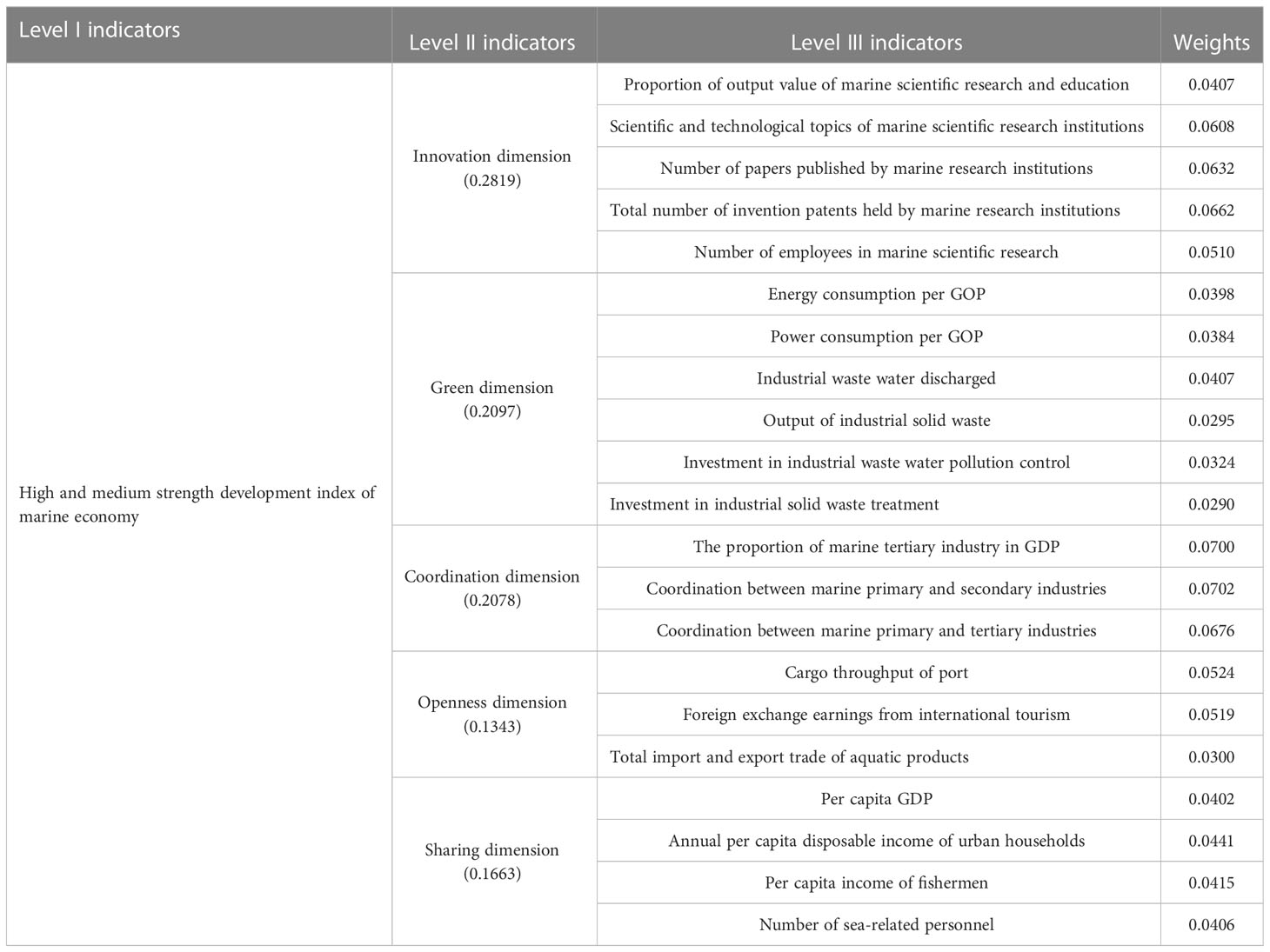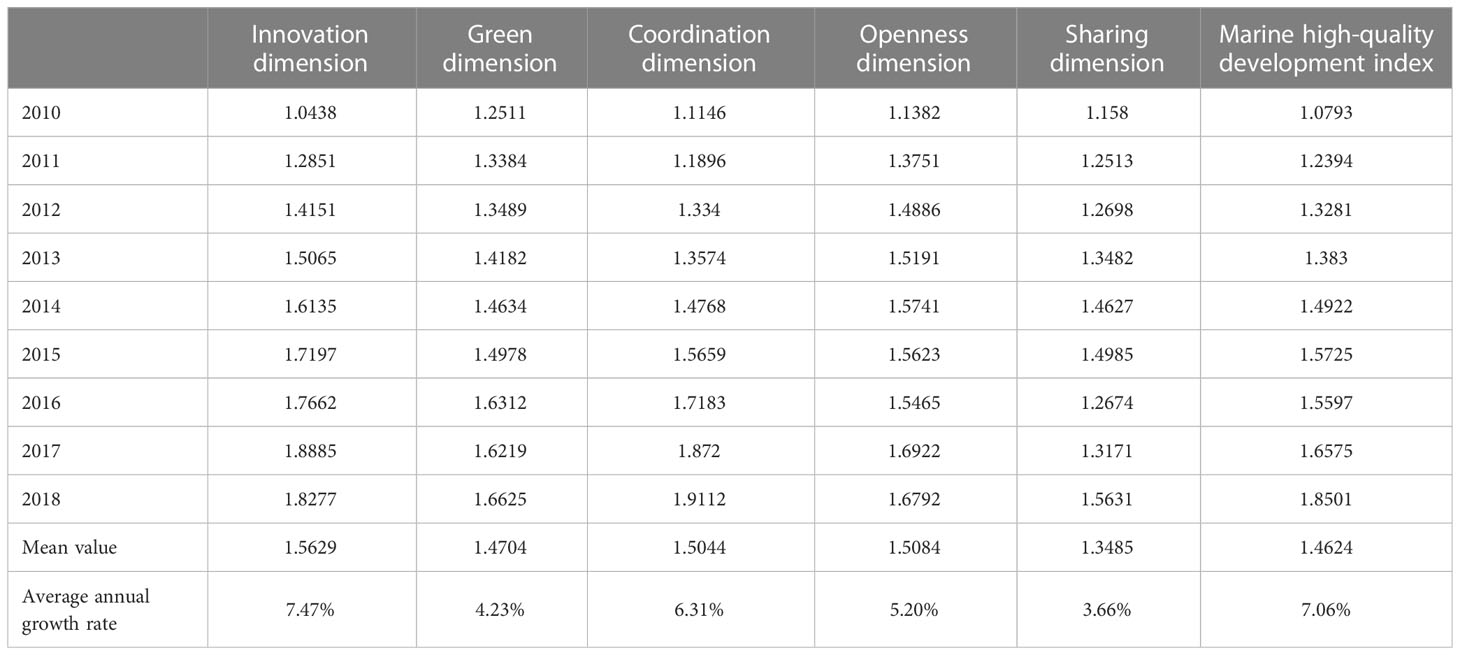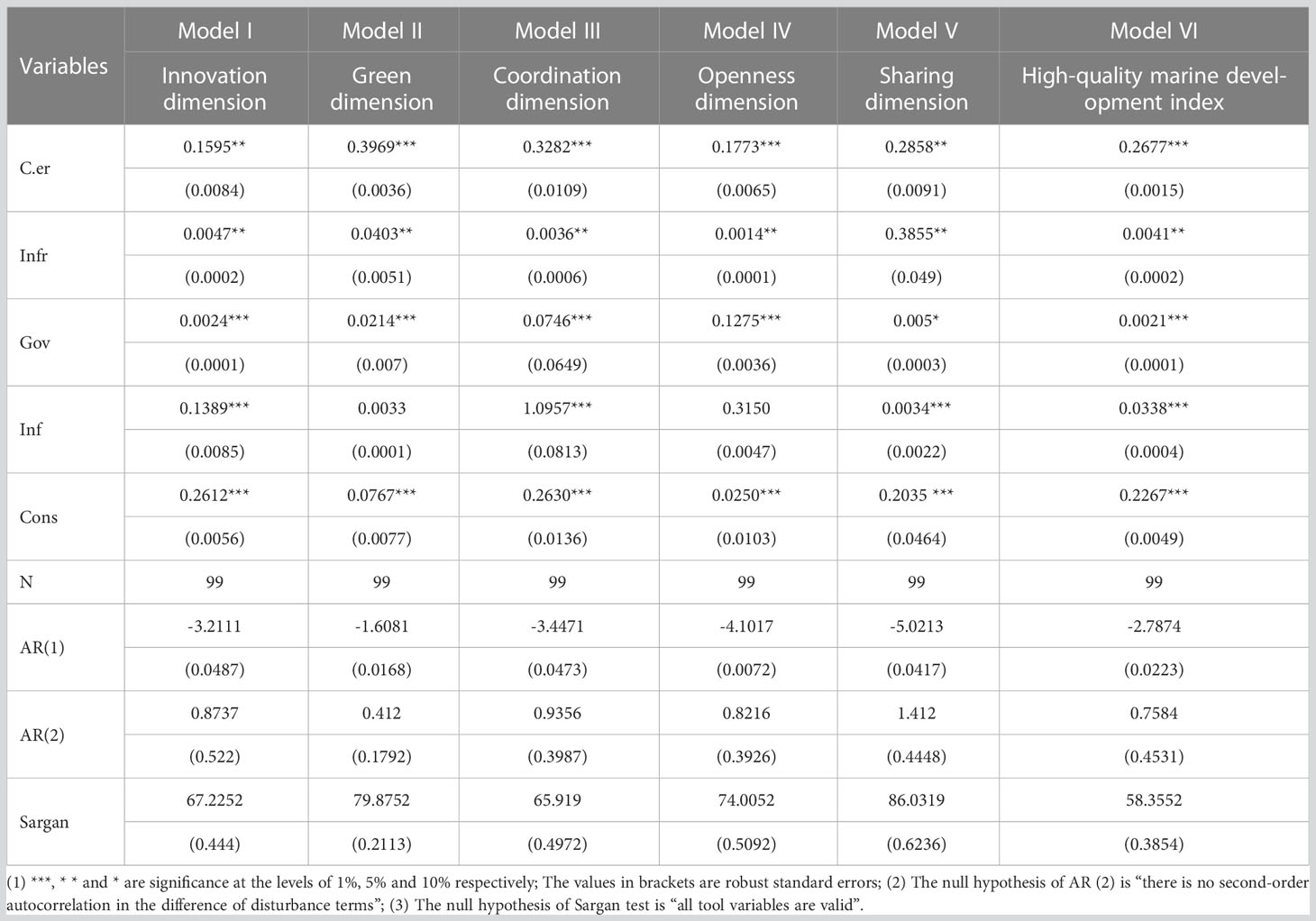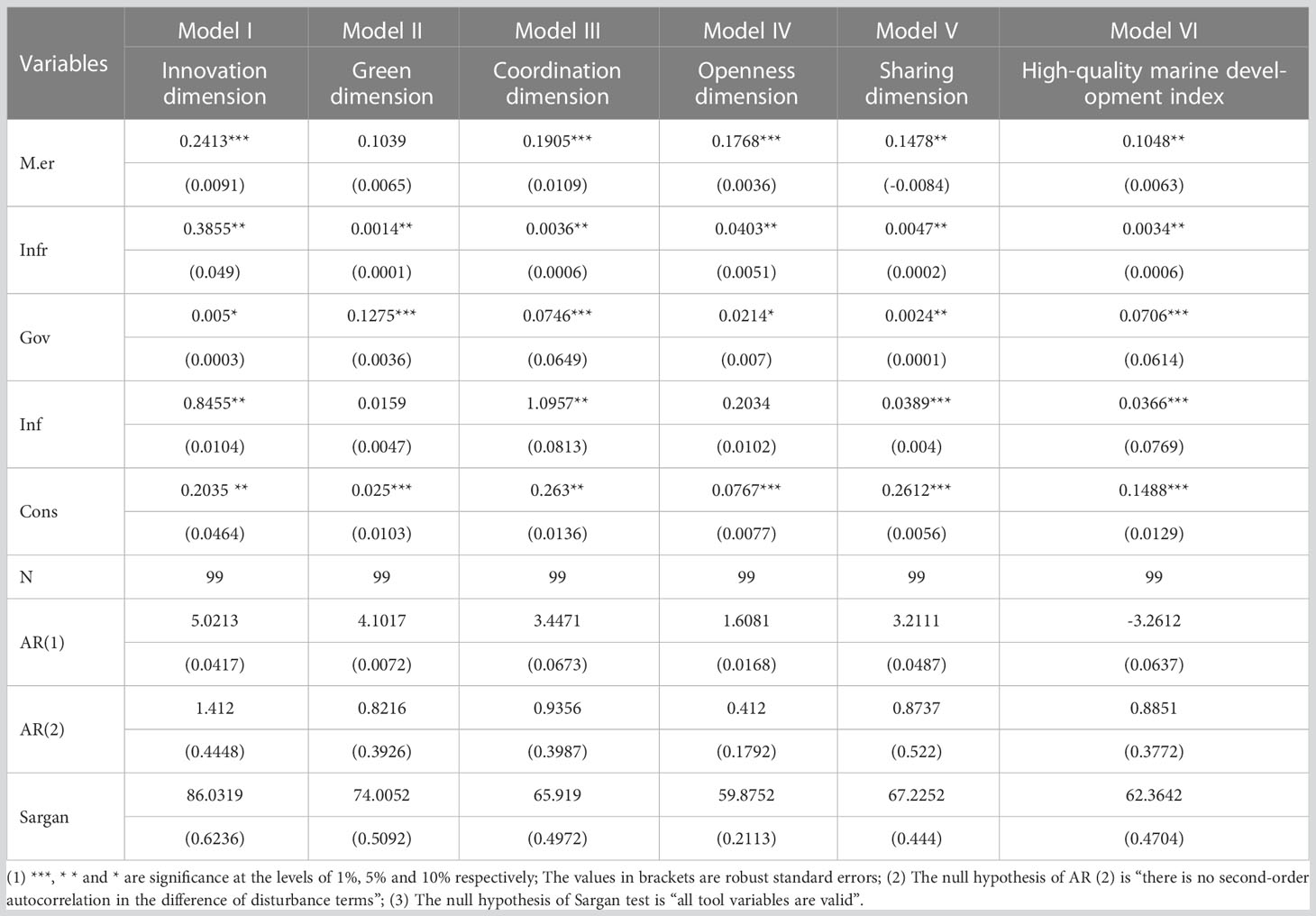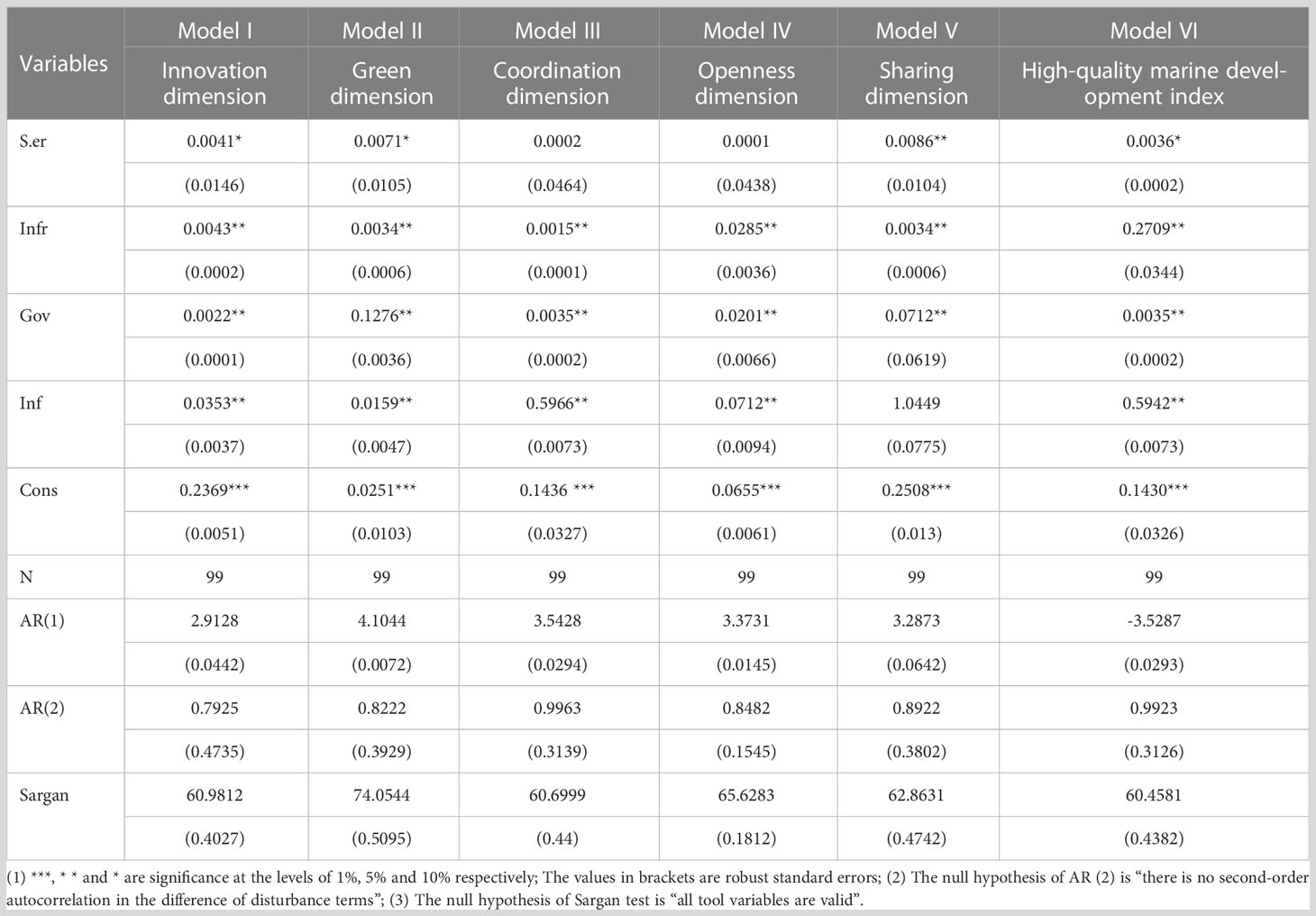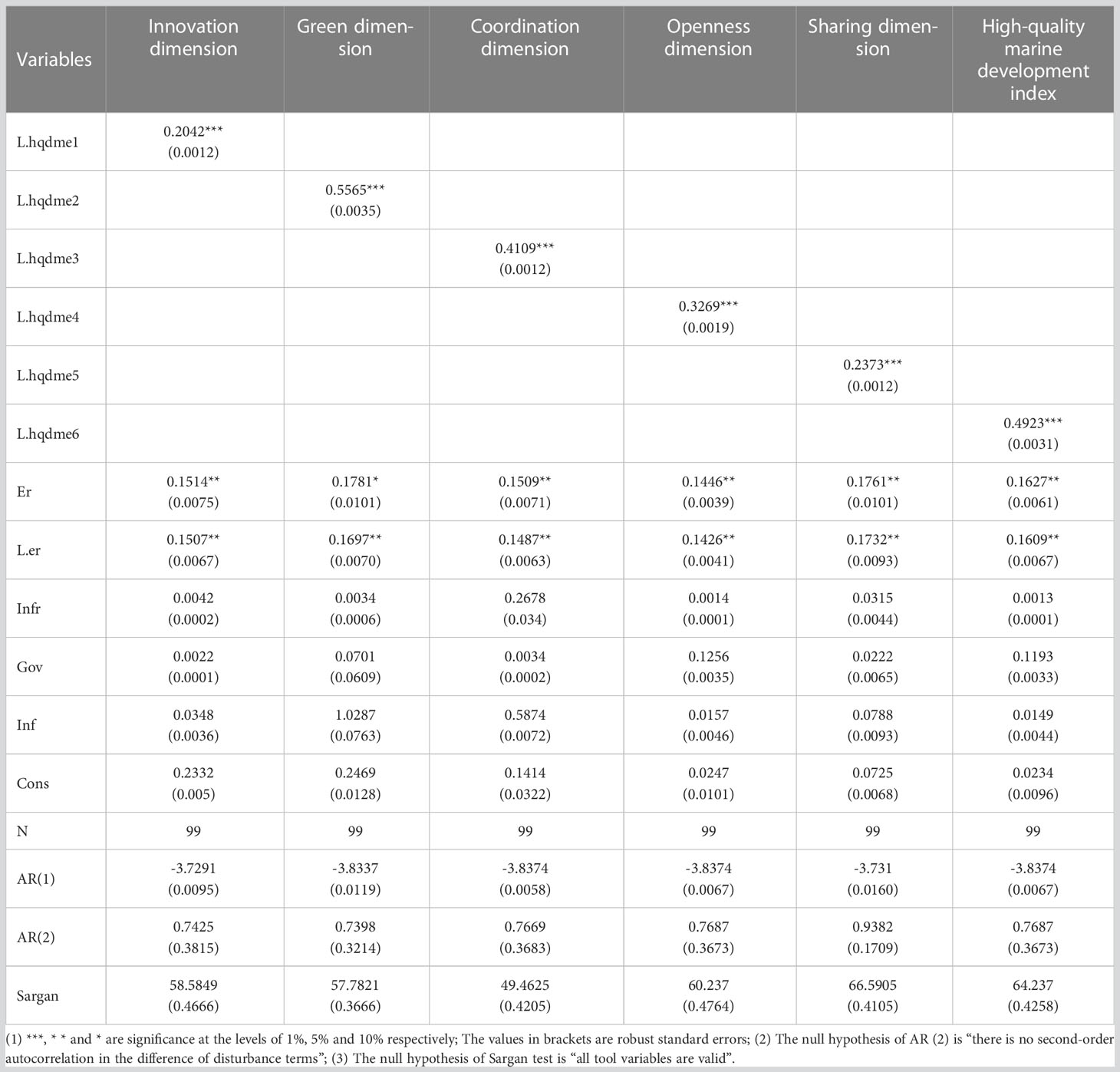- 1Institute of Marine Economy and Culture, Shandong Academy of Social Sciences, Qingdao, China
- 2School of Economics and Management, Shandong University of Science and Technology, Qingdao, China
As the high-quality development of marine economy cannot be separated from the improvement of marine ecological environment quality, it is of great importance to clarify the relationship between environmental regulation and the high-quality development of marine economy. In this paper, firstly, an aggregative indicator system of high-quality development of marine economy was constructed to dynamically describe and analyze the overall and provincial trends of high-quality development indicators of marine economy from two dimensions: time trend and spatial pattern. Then, a theoretical analysis framework of environmental regulation affecting the high-quality development of marine economy was constructed, and the theoretical explanation and hypotheses were put forward and tested from the action mechanism of different types of environmental regulation affecting the high-quality development of marine economy, such as command control, market incentive and public participation. At last, the paths and countermeasures of environmental regulation to promote the high-quality development of marine economy were put forward combined with the theoretical analysis and empirical test results.
1 Introduction
The 21st century is a marine century. The rapid development of marine economy and population in the world has brought a series of development problems, such as the depletion of land resources, the deterioration of ecological environment, and the increasing contradiction between population and land resources. As a result, all countries in the world have begun to pay attention to the oceans, seek their development, speed up the development of marine resources, and deeply explore the huge potential of the oceans. Thus, the strategic position of the oceans has been highlighted. By making full use of their superior geographical advantages, the coastal states have formulated a series of important policies, mainly in marine economic development, marine ecological protection and marine rights and interests maintenance. The development of marine economy has also witnessed that human activities have caused damage to marine ecosystems, resulting in changes in the marine environment, which is not conducive to the sustainable development of marine economy. China’s economic development has entered a new period of improving quality and increasing efficiency. “High-quality” will become the key word of China’s economic construction in the coming period, and the ocean is the main strategic area of high-quality development (Smith, 2003), which indicates that China’s marine economic development has entered a critical period of transformation from high-input and low-efficiency scale-speed type to high-tech-oriented and economic structure-optimized quality-benefit type, and from factor investment-driven to innovation-driven. Moreover, in recent years, because all countries in the world have begun to attach importance to ocean development, the international ocean competitiveness has been enhanced. High-quality development of marine economy is an important means of building a marine power strategy, and the development of marine economy needs to rely on the support of scientific and technological innovation. Ocean economic powers in the world have made long-term plans for marine science and technology, and have incorporated marine technology development and marine scientific research into the national strategic planning arrangements, so that marine science and technology can penetrate into various marine industrial sectors, bringing huge influence. The improvement of marine environmental quality can’t be separated from the extensive participation of everyone, which not only requires the government to strengthen management through policies and systems, but also needs to study the influence of command-based, market-driven and public participation-based environmental regulation on the high-quality development of marine economy, which is conducive to analyzing the causes of marine environmental damage and marine ecological deterioration. Therefore, the relationship between environmental regulation and high-quality development of marine economy should be clarified in order to provide reliable decision-making for the government to improve the quality of marine economy in various coastal areas. This paper contributes to the literature in the following ways. First of all, the related literature on environmental regulation, high-quality development of marine economy and the relationship between environmental regulation and high-quality development of marine economy were sorted out, which provides reference and inspiration for this paper. Then, a composite indicator system of high-quality development of marine economy was constructed to dynamically describe and analyze the overall and provincial trends of high-quality development indicators of marine economy from two dimensions of time trend and spatial pattern, which lays a realistic foundation for this research. Next, a theoretical analysis framework of the influence of environmental regulation on the high-quality development of marine economy was constructed, and the theoretical explanation and hypotheses were put forward from the action mechanism of different types of environmental regulation on the high-quality development of marine economy, such as command control, market incentive and public participation. Fourthly, the intensity and laws of different types of environmental regulation on the high-quality development of marine economy were investigated based on theoretical analysis, and the hypotheses were tested. Finally, the paths and countermeasures of environmental regulation to promote the high-quality development of marine economy were put forward combined with the theoretical analysis and empirical test results.
2 Literature review
2.1 Research on environmental regulation
Environmental regulation, an important means for the government to manage the environment in order to overcome the market failure caused by improper use of the environment in economic activities, is also a government regulation on environmental protection and a way for the government to intervene in economic activities. It is becoming more and more important with the increasingly severe environmental pollution. Environmental regulation policies are formulated and implemented not only to effectively protect and improve the ecological environment, but also to take sustainable economic development as the ultimate goal. Wang (2016) believed that environmental regulation, with the help of government forces, is a traditional tool to solve environmental problems and also an important means to improve the economic performance and environmental performance of enterprises (Wang et al., 2016). Zhao Yumin (2009) held that environmental regulation is the explicit or implicit environmental protection institutional measures taken by the government administrative departments to internalize the external costs of the environmental impact of economic entities in order to achieve the purpose of environmental protection (Yumin et al., 2009). Clearly, how to accurately measure the regulatory intensity is very important when studying environmental regulatory policies. In the existing literature, environmental regulation is mainly studied from the following three aspects: one is to measure and study environmental regulation as a whole, the other is to measure and study environmental regulation tools by categories, and the third is to evaluate the effects of specific environmental protection policies.
2.2 Research on high-quality development of marine economy
The early scholars’ comprehensive evaluation on the quality of economic development only stayed at a single level of economic aggregate growth. For example, Adam Smith, a famous economist, put forward in The Wealth of Nations that economic growth is the growth of national wealth. Affected by him, economists also thought that the quality of economic growth has the same connotation as the quality of economic development (Smith, 2003). Vinod Thomas constructed the economic growth evaluation indicator system from the income growth, human development, and environmental sustainable evaluation (Thomas et al., 2001). Researchers found that social contradictions did not change with the growth of economic aggregate, and people formed the viewpoint that the quality of economic development was different from that of economic growth from then on. Mlachila proposed that high-quality economic growth in developing countries should be high-quality development with increasing growth rate and increasing persistence (Mlachila et al., 2014). Pasquale Tridico believed that high-quality economic development will have a positive influence on human society, such as the continuous reduction of poverty and the gradual satisfaction of people’s living needs. He also pointed out that there is a certain conflict between human society and economic development (Tridico, 2010). The high-quality marine economy is put forward on the basis of the concept of high-quality of economy, which is a new concept. The related research in China is just at the beginning stage, and there are few research results, mainly involving high-quality evaluation indicators, countermeasures and suggestions, and spatial scale of marine economy. Ren et al. incorporated environmental factors into the model to measure marine green efficiency, and put forward relevant policy suggestions (Tingley et al., 2005). Grace Wang et al. analyzed the marine environmental efficiency of cruise companies (Jamnia et al., 2015). J.C. Marques and A. Basset believed that only by maintaining the coordinated development of human society and the ecological environment can human survival be protected and ecological system health be maintained (Marques et al., 2009). Martinez proposed that it is necessary to focus on the coordinated development of the three systems of marine economy, marine ecology and marine society in order to achieve the sustainable development of the oceans in coastal areas (Martinez et al., 2006). The theoretical system of marine economy is continuously developing and improving. Researchers in the international academic community began to solve the complex problems about the process of marine economic growth, such as early marine industrial structure, stable development of marine economy and marine economic system, and successively put forward research theories such as regional marine economic efficiency and optimal management of coastal zones. Smith-godfrey redefined the “blue economy” according to his own understanding, and believed that land-sea linkages should be strengthened in the economic development of regional coastal zones to promote the coordinated development of land and sea (Smith-Godfrey, 2016).
Lu Yayun calculated the high-quality development level of marine economy in China’s coastal provinces and cities according to the new development concept (Asian Games et al., 2019). Han Zenglin put forward the countermeasures of resource utilization, industrial development and regional coordination for the high-quality development of marine economy (Zenglin et al., 2019). Wang Zeyu, Lu Yayun, et al. evaluated the high-quality development level of China’s marine economy from the national scale level (Zeyu et al., 2020). Yuan Feng, Xiang Xiaomei, et al. gave suggestions and countermeasures for the high-quality development of marine economy in the Guangdong-Hong Kong-Macao Greater Bay Area by analyzing the current economic situation there (Xiaomei and Chao, 2020; Yuan et al., 2020). Zhao Hui analyzed the high-quality development of Tianjin’s marine economy by analyzing its present situation internally and externally (Hui et al., 2020).
2.3 Research on the influence of environmental regulation on the high-quality development of marine economy
At present, there is no research on the influence of environmental regulation on the high-quality development of marine economy in the literature, and few studies on the influence of environmental regulation on the development of marine economy. Chen Jian pointed out that there is a threshold for the influence of environmental regulation on the marine economy, and the positive influence of environmental regulation on the marine economy will significantly increase when the value is greater than this threshold (Jian, 2021). Ning Liang et al. thought that environmental regulation will reduce the efficiency of marine industry, and technological innovation and FDI have a negative impact on the relationship between environmental regulation and marine industry efficiency, and their regulating effects can complement each other. FDI can still mitigate the negative impact of environmental regulation on the efficiency of marine industry when the level of technological innovation is low, which makes it possible for the coordinated development of environmental protection and economic growth. Coastal provinces should strengthen and improve the ability of scientific and technological innovation and achievement transformation and continuously attract high-quality FDI to alleviate the constraints of environmental regulations, so as to achieve a win-win situation of environmental protection and the efficiency of the marine industry and achieve high-quality development of the marine economy (Jing et al., 2022). Xu Ruiheng et al. found through comprehensive analysis of China’s marine economic development that increasing the transfer payment rates of residents, enterprises, local governments and the central government to the sea and reducing the value-added tax rate can both increase the amount of marine ecological compensation, but the effect of the increase decreases in turn, and that the increase in the transfer payment rates of enterprises to the sea can significantly increase the marine income without obvious negative economic effects (Ruiheng and Xinyue, 2020).
Scholars have analyzed the types, measures and economic growth effects of environmental regulations and defined the connotation of high-quality development of marine economy. There are few literatures on in-depth investigation and analysis of the high-quality development trend of marine economy. The existing literatures are rich in research on the influencing factors of the high-quality development of marine economy, but relatively little on the influence and transmission mechanism of environmental regulation on the development of marine economy.
The remainder of this paper are organized as follows: Section 2 reviews the relevant literature on environmental regulation, high-quality development of marine economy and the influence of environmental regulation on the high-quality development of marine economy. Section 3 measures and analyzes high-quality development of marine economy. Section 4 examines the impact of environmental regulation on the high-quality development of marine economy. Section 5 presents conclusions and implications.
3 Analysis on the mechanism of environmental regulation affecting the high-quality development of marine economy from the perspective of different subjects
3.1 Command control type environmental regulation promoting high-quality development of marine economy
Command control type tools refer to the direct management and mandatory supervision of production behavior by the national administrative departments in accordance with relevant laws, regulations, rules and standards, which can be divided into national laws and regulations, and local laws and regulations promulgated by local governments at all levels. Under the constraints of command control environmental regulations, such acts as government environmental subsidies and governance investment will have an impact on the marine ecological environment. As shown in Figure 1, environmental regulation can promote the government to strengthen marine environmental protection subsidies and investment in marine environmental governance, strengthen marine environmental supervision, improve the efficiency of the use of marine resources, reduce marine pollution emissions, improve the performance of marine environmental governance, and promote the transformation and upgrading of the marine industrial structure, which is conducive to the improvement of the quality of the marine environment and the high-quality development of the marine economy.

Figure 1 Command control type environmental regulation promoting high-quality development of marine economy.
Thus, hypothesis 1 was proposed in this paper: command control type environmental regulation helps promote high-quality development of marine economy.
3.2 Market incentive type environmental regulation affecting the high-quality development of marine economy
The market incentive type tool means to use explicit economic incentive in the form of fees or subsidies to promote marine enterprises to make an independent choice between the costs and benefits of marine pollution discharge to determine the production technology level and marine pollution discharge volume of the marine enterprises. As shown in Figure 2, according to the specific operation principles, the market incentive tools can be divided into two categories: one is the policy tools that advocate the internalization of externalities by government intervention, including the punitive measures of imposing fines on marine pollution and the positive incentive tools that provide compensation and subsidies for energy-saving and marine ecological projects; the other is the policy tools of the new institutional economics school that emphasizes the use of the market mechanism itself to solve externalities, whose main policy tool is the marine emission trading institution. The marine emission trading institution improves the enthusiasm of marine enterprises in pollution control, and controls the total amount of marine pollution within a certain range, thus changing the marine pollution control from the compulsory behavior of the government to the conscious market behavior of marine enterprises.
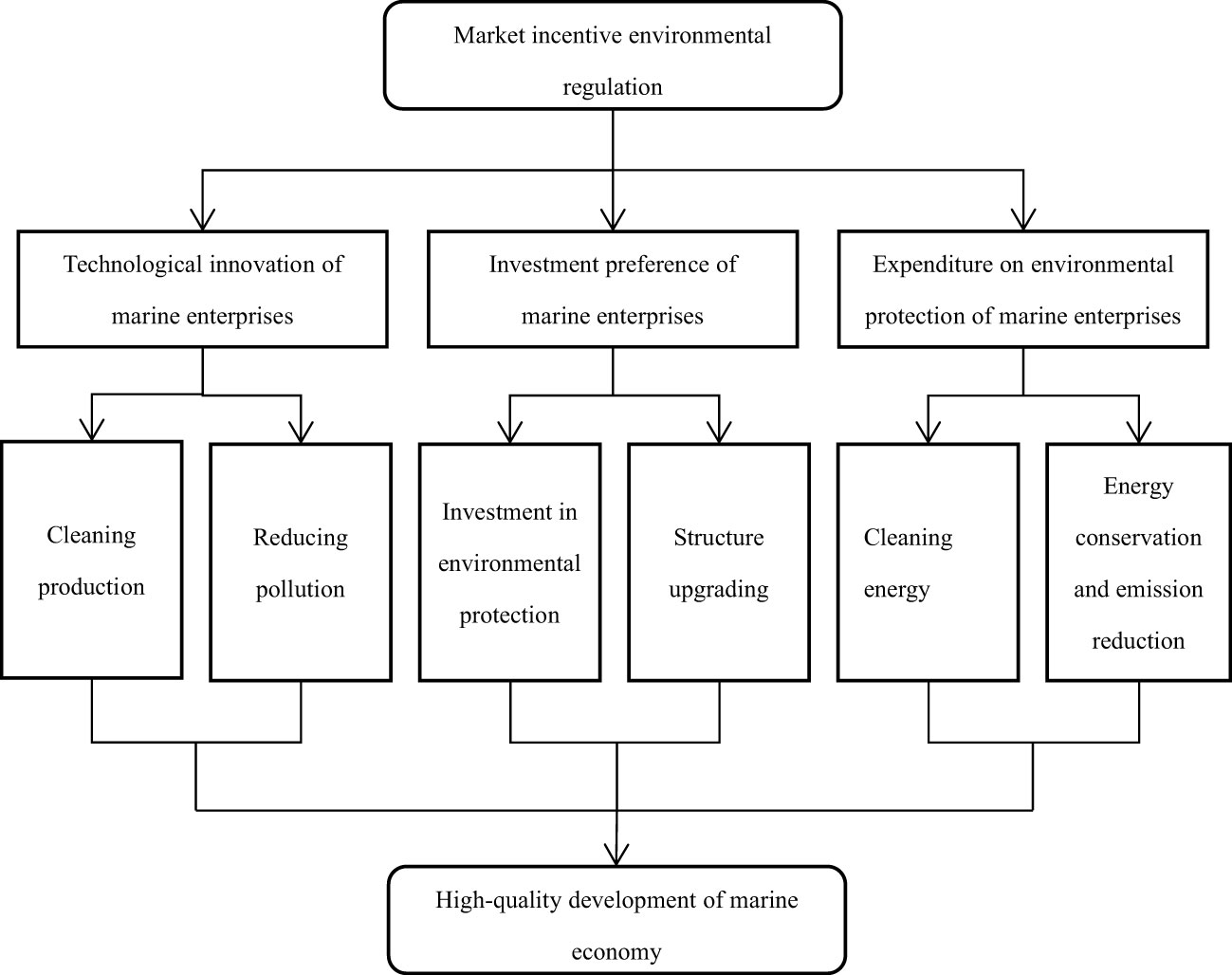
Figure 2 Market incentive type environmental regulation affecting the high-quality development of marine economy.
Thus, in this paper, hypothesis 2 was proposed: market incentive environmental regulation can promote the high-quality development of marine economy.
3.3 Public participation type environmental regulation affecting the high-quality development of marine economy
The public participation type tool mainly refers to indirectly promoting the stricter implementation and enforcement of relevant marine environmental protection laws and regulations and technical standards through social public opinion, social moral pressure, persuasion and other measures. The core is to influence the marine environmental governance performance of the whole society through public participation. The public can express their basic demands and positions on marine environment policy issues to the government departments through a variety of channels. For example, social media are used by the public to express concern about marine environmental events and to influence and facilitate policy development and implementation by relevant administrative authorities. In addition, the public can promote the attention of local administrations to marine environmental issues in a negative way, namely, by voting with the feet. Human beings have a natural preference for the pursuit of interests. People are the main body of social activities, and the source and motivation of people engaging in all activities are derived from material interests. Marx pointed out: “Once ‘thoughts’ leave ‘interests’, they will make a fool of themselves.” Seeking benefits is the motivation of all economic activities, and the behavior choice of economic subjects reflects the goal of obtaining benefits. The excessive pursuit of marine economic interests and neglect of marine environmental protection, however, lead to marine environmental pollution and destroy the living environment of human beings. A better life requires strengthening the public’s demands for environmental protection. As shown in Figure 3, the increasing intensity of environmental regulation has prompted the public to pay more attention to and attach importance to marine environmental protection. Through green consumption and environmental protection participation, local governments have been urged to improve marine environmental protection policies, and marine-related enterprises have been encouraged to increase R&D investment, promote technological innovation, enhance green development efficiency, and promote high-quality development of marine economy.
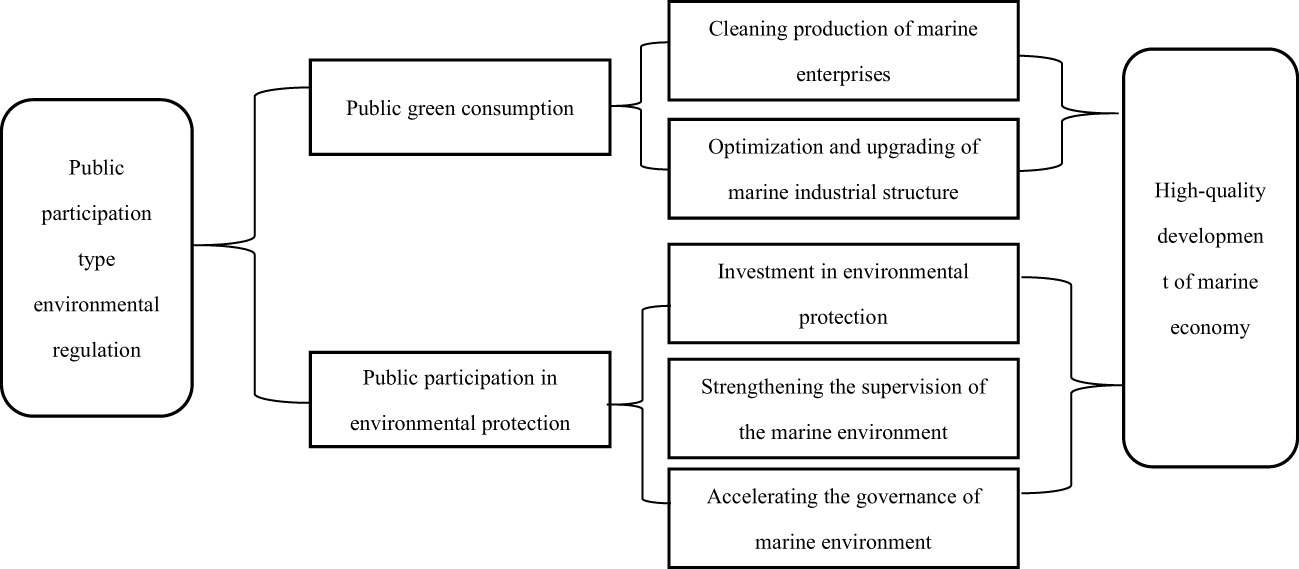
Figure 3 Public participation type environmental regulation affecting the high-quality development of marine economy.
Thus, in this paper, hypothesis 3 was put forward: public participation type environmental regulation is helpful to promote the high-quality development of marine economy.
4 Measurement and evaluation of high-quality development of marine economy
4.1 Construction of an indicator system for measuring high-quality development of marine economy
It is a comprehensive and complicated systematic problem to measure the high-quality development level of marine economy and to specify and index the characteristics of high-quality development of marine economy. In view of the new requirements for economic development under the background of the new normal, the development of marine economy in the new era requires not only to continuously promote the internal development of the marine economic system, but also to focus on the coordination and interaction between the internal economic system and external factors such as environment and society. Therefore, the evaluation of the high-quality development of marine economy should focus on the “five development concepts” in the new era of innovation, coordination, green, openness and sharing.
Starting from the basic requirements for high-quality development of marine economy and the “five development concepts” in the new era, and following the principle of indicator system construction, the evaluation indicator system for high-quality development of regional marine economy was constructed from the following aspects, as shown in Table 1.
4.2 Measurement method of high-quality development of regional marine economy
4.2.1 Selection of measurement method
According to the literature review, scholars mainly build high-quality development indicator systems through objective and subjective weighting methods. Entropy method is one of the common objective weighting methods. The larger the degree of dispersion of an index is, the smaller the entropy value will be, and it will be given a greater weight. Besides, as the entropy method is based on the characteristics of the indicator data, it can avoid the deviation of human decision. Subjective weighting method refers to giving different weights to each indicator through the experience of experts and scholars. Its advantage is that it can give realistic significance to the weights, rather than completely according to the changes in data. However, the evaluation results are not objective enough to reflect the reality. In view of the fact that entropy method can determine the optimal weight of indicators, in this paper, the entropy method was used to get the weight of each evaluation indicator by referring to Wei Min and Li Shuhao’s practice. The specific implementation steps are as follows:
(1) Standardization. The range method was used to standardize the indicators in the indicator system:
Where, xij and Xij respectively represent the data of the j-th high-quality development evaluation indicator of the i-th province before and after standardization. Since the range method would result in some data having a normalized value of 0, the normalized data was smoothed by adding 1.
(2) The indicators were quantified in the same degree by the formula as follows:
(3) The entropy value Ej of each indicator was calculated based on the normalized indicator data Xij by the formula as follows:
(4) The redundancy of the entropy value was calculated based on the information entropy Ej by the formula as follows:
(5) The weight of each indicator was calculated based on the redundancy Dj by the formula as follows:
(6) The multi-objective linear weighted function method was used to calculate the composite index Qi of high-quality development of marine economy in each province by the formula as follows:
Thus, the comprehensive index of high-quality development Qi was obtained. The larger Qi, the higher the level of high-quality development of the province. On the contrary, the lower.
4.2.2 Data source and indicator description
As mentioned above, the high-quality development of marine economy includes five dimensions: innovation, green, coordination, openness and sharing, each of which needs to be measured by multiple indicators. Based on the availability and continuity of data, the original data of each indicator in this paper were mainly from China Statistical Yearbook, China Marine Statistical Yearbook, China Fishery Statistics Yearbook, China Environment Yearbook and China Transport Yearbook from 2011 to 2019. In addition, missing data from some cities were supplemented by interpolation. In view of the spatial distribution characteristics of marine economic development, 11 coastal provinces and cities were selected as the study area, and the spatial and temporal variation trends of economic development quality in each area were analyzed, in order to provide reliable decisions for improving the quality of marine economic development in each area. The descriptive statistical results of each indicator are shown in Table 2.
4.3 Analysis on measurement results of high-quality development of marine economy
4.3.1 Analysis on time evolution of high-quality development of marine economy
In this paper, the basic indicator system was constructed from five dimensions: innovation, green, coordination, openness and sharing to comprehensively evaluate the high-quality development level of marine economy. Finally, the weight value of the evaluation indicator was obtained according to the above measurement method. As shown in Table 3, innovation has the highest weight in the composite index of high-quality development of marine economy from 2010 to 2018, with a weight coefficient of 0.2819, indicating that the improvement and optimization of innovation dimension of marine economy has the greatest contribution to boosting the quality improvement of marine economy development during this period. Secondly, the green dimension and coordination dimension also have relatively high weights in the composite index of high-quality development of marine economy, with the weight coefficients of 0.2097 and 0.2078 respectively, indicating that green development and coordination and sharing play a decisive role in the process of high-quality development of marine economy, and the role of green development is greater. By contrast, the weights of the open dimension and the sharing dimension play a smaller role in the composite index of high-quality development, with the weight coefficients of 0.1663 and 0.1343, respectively.
Based on the weight coefficients of each basic indicator and dimension indicator in Table 3, the five dimension indicators and high-quality development composite index of marine economy during 2010-2018 were calculated, and the calculation results are shown in Table 4.
To investigate the high-quality development level of China’s marine economy, and visually reflect its change trend, and identify the temporal change characteristics of high-quality development of marine economy, in this paper, the average value of high-quality development of marine economy in 11 coastal provinces and cities from 2010 to 2018 was plotted in Figure 4. Judging from the overall change trend, the composite index of high-quality development of marine economy showed a continuous upward trend from 2010 to 2018, mainly due to the combined effect of the five dimensional indexes of high-quality development of marine economy. Overall, the average value of the high-quality development index of the marine economy increased from 1.0793 to 1.8501, by 0.7708, with an average annual growth of 7.06%. From the perspective of different periods, the growth rate in 2010-2011 was large, the quality of marine economic development continued to climb in 2010-2014, declined slightly in 2015-2016, and gradually increased after 2017.
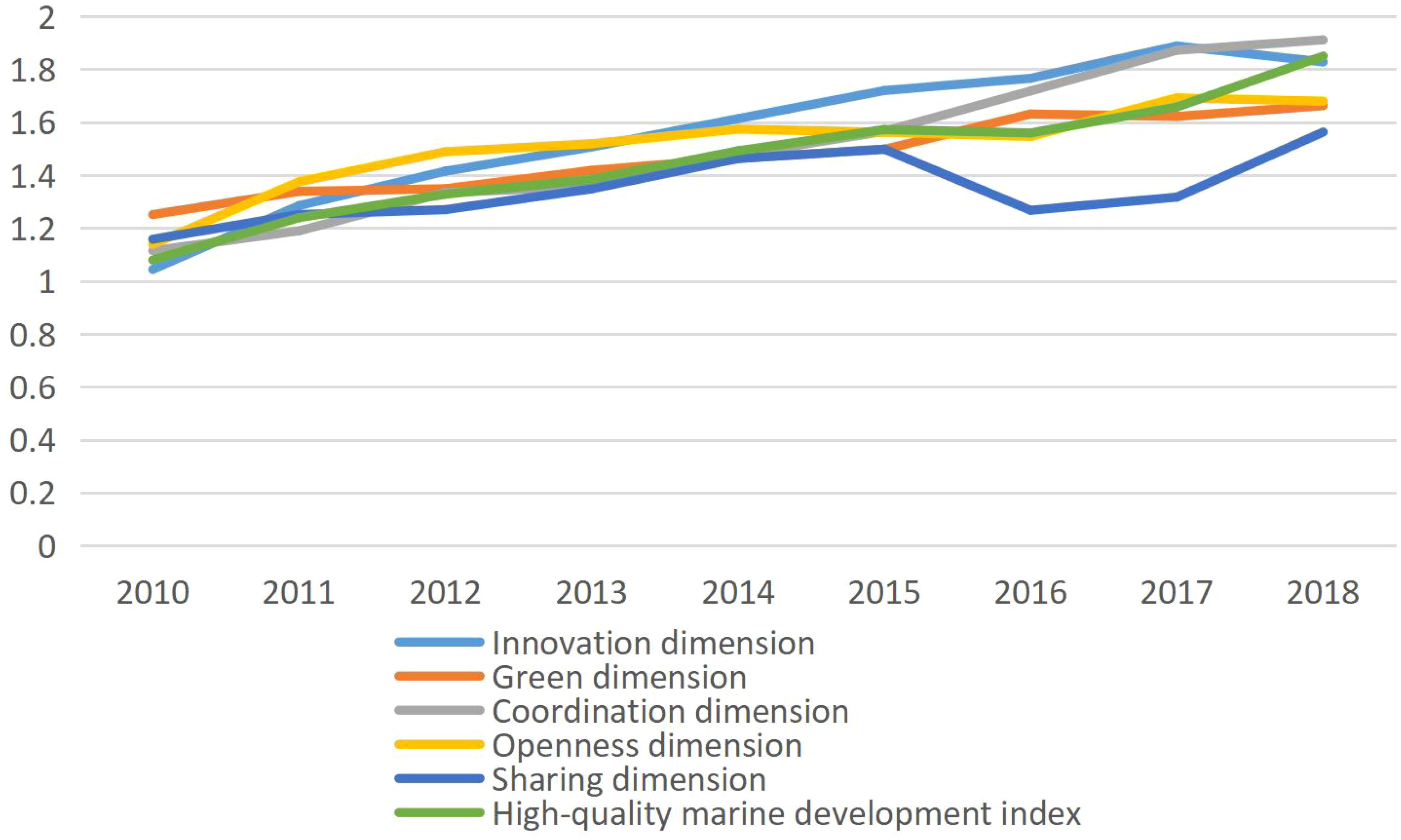
Figure 4 High-quality development index of China’s marine economy from 2010 to 2018 and the changing trend of each dimension.
In terms of dimensions, the indicator of high-quality development and innovation dimension of marine economy from 2010 to 2018 showed a continuous growth trend, rising from 1.0438 in 2010 to 1.8277 in 2018, with an average of 1.5629, with an average annual growth rate of 7.47%, the fastest growth rate among the five dimensions, reflecting that all participants in China’s marine economic system paid more attention to the development of innovation field than other dimensions. As a whole, the indicator of green dimension showed a fluctuating growth trend, from 1.2511 in 2010 to 1.6625 in 2018 after the fluctuation in 2017, with an average annual growth rate of 4.23%, indicating that China’s marine economy is paying more and more attention to green development in the process of improving the development quality. The coordination dimension showed a gradual improvement trend, from 1.1146 to 1.9122 in 2010-2018, with an average annual growth rate of 6.31%, indicating that the structural adjustment of China’s marine industry is gradually improving. The dimension of openness increased from 1.1382 in 2010 to 1.6792 in 2018, an increase of 0.541, with an average annual growth rate of 5.20%. The sharing dimensions showed the smallest increase, from 1.1580 in 2010 to 1.5631 in 2018. Overall, from 2010 to 2018, China’s marine economy showed a good development trend in five dimensions: innovation, green, coordination, openness and sharing, indicating that China’s marine economy has gradually changed from the traditional emphasis on economic output to a coordinated development stage in which the five dimensions develop together.
4.3.2 Analysis on regional differences in the high-quality development of marine economy
Due to the heterogeneity of factors endowment, geographical environment, development ability, policy orientation, industrial structure, green investment and other aspects in China’s coastal regions, there are differences in the high-quality development level of marine economy. Therefore, in this paper, the change trend at the provincial level in China’s coastal regions was investigated, and the measurement results are shown in Figure 5.
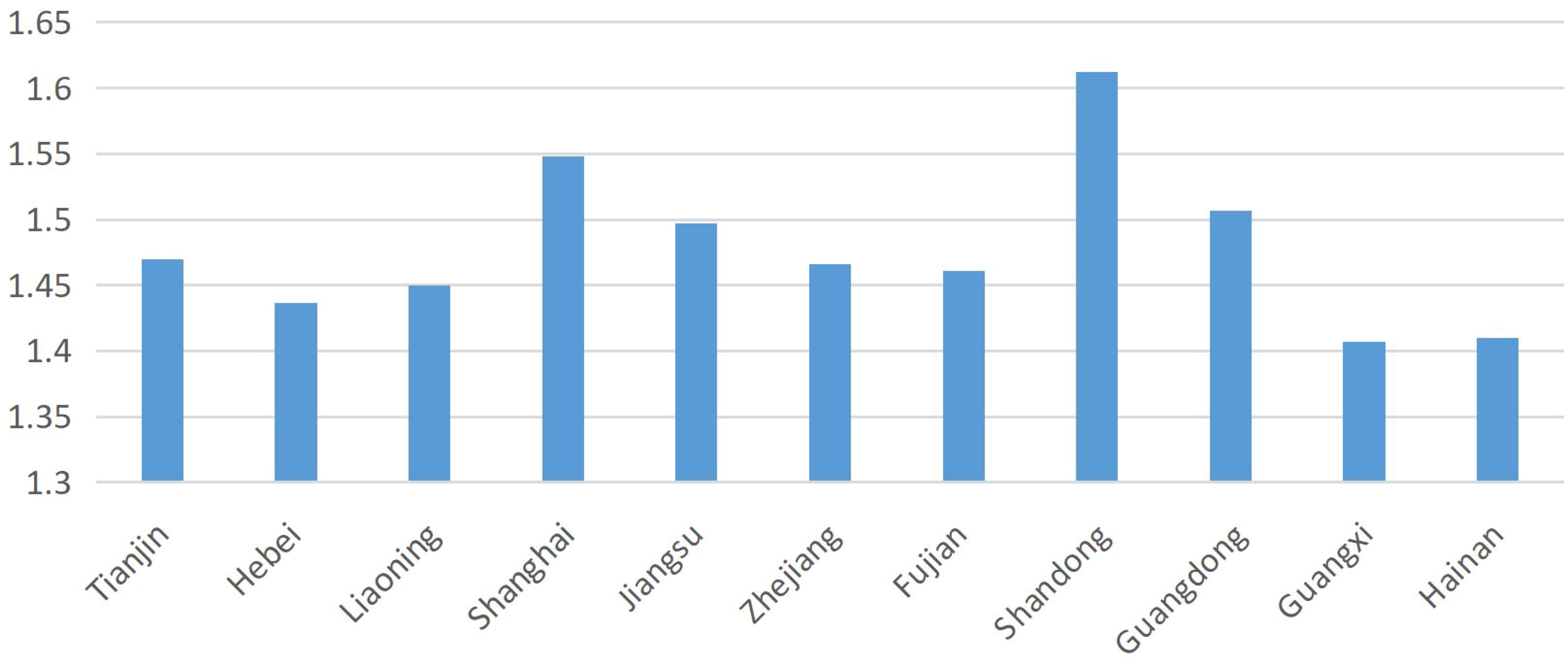
Figure 5 Comparison of average values of high-quality development index of marine economy in coastal areas.
As far as the composite index of high-quality development of marine economy is concerned, the high-quality development of marine economy in Shandong Province was more excellent than that in other regions. The average value of the composite index in 2010-2018 was 1.6124, which was 0.2052 different from that of Guangxi, which ranked last, and 1.1458 times that of Hainan, with obvious comparative advantages. In addition to Shandong, Shanghai, Guangdong and Jiangsu had a composite index of high-quality marine economic development that was higher than the average of 11 regions. Tianjin, Zhejiang and Fujian had a development index that was slightly lower than the average, the composite index was around 1.47, which was 54.55% higher than the national average of high-quality development of marine economy. On the whole, there are great differences in the high-quality development level of marine economy among different regions, and the spatial distribution presents a cross trend. The high-quality development status of marine economy in most regions is relatively excellent.
With respect to subdivision dimensions, there are great differences in different dimensions among different regions. According to Figure 6, the regions where the innovation dimension of high-quality development of coastal marine economy in 2010-2018 was greater than the average value of 1.3897 were Shandong, Shanghai, Jiangsu and Guangdong, among which Shandong and Shanghai had the innovation dimension indicators greater than 1.7, exceeding the average levels of 11 regions by 34.22% and 25.96% respectively and the national average levels by 19.34% and 12% respectively. Jiangsu and Guangdong had the innovation dimension indicators of 1.4304 and 1.4203 respectively, exceeding the level of 11 regions by 2.92% and 2.02%. Except for the above regions, the innovation dimension indicator of other regions did not reach the average level, among which that of Hainan region was the lowest, at 1.0941, which was only 58.66% of that of Shandong, showing obvious regional differences. In view of the fact that the innovation dimension has the highest weight in the composite index of high-quality development of marine economy, the improvement and optimization of marine innovation dimension has the greatest contribution to the promotion of development quality during this period. In order to further improve the innovation capability of each province and narrow the development gap between provinces, efforts should be made to promote innovation investment and raise the level of human capital, so as to promote innovation level to boost the development of marine economy. At the same time, the spatial flow of innovation resources should be increased. On the premise of giving full play to the region’s own advantages, combined with the development experience of the region with a record high level, the regional marine innovation capacity should be enhanced.
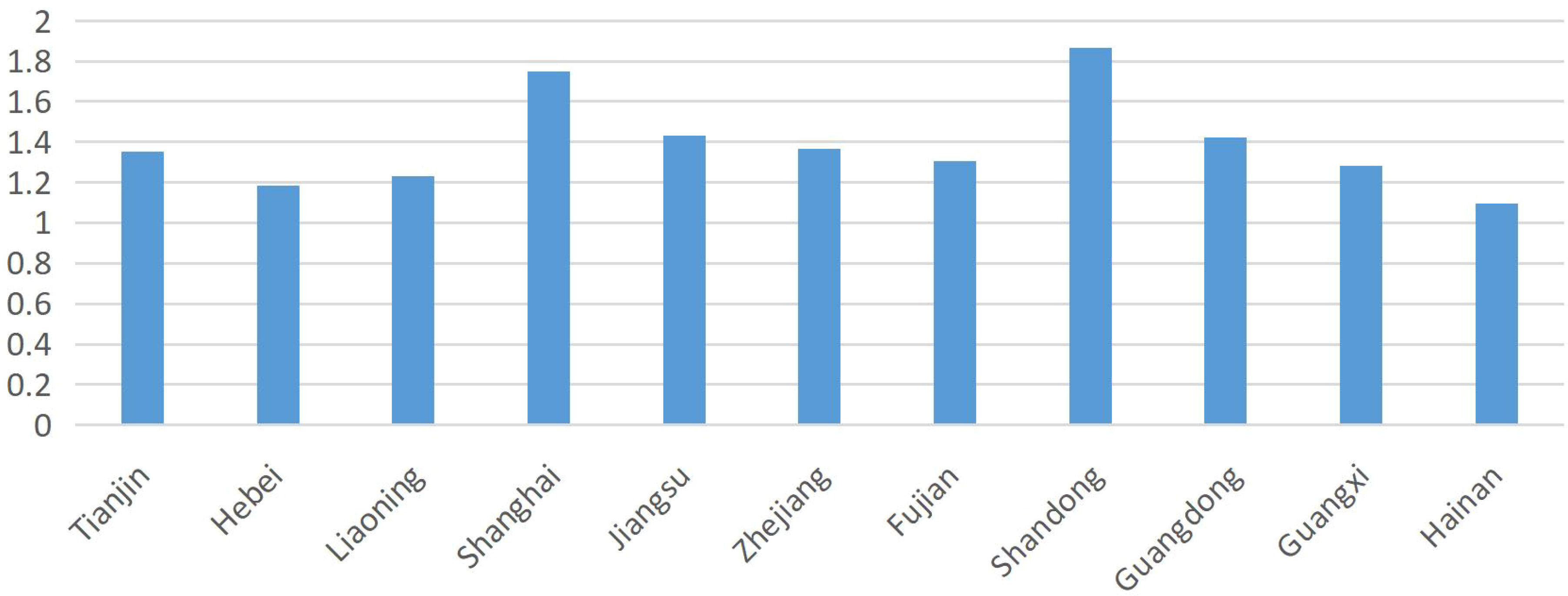
Figure 6 Comparison of the average value of innovation dimension indicator of high-quality development of marine economy in coastal areas.
According to the results reported in Figure 7, the top three regions in the green dimension indicator of high-quality development of marine economy in coastal areas from 2010 to 2018 were Shandong, Guangdong and Fujian, with the green dimension indicators of 1.537, 1.5363 and 1.5215 respectively. The last three provinces were Guangxi, Hebei and Liaoning, with the green dimension indicators of 1.3705, 1.4102 and 1.4470 respectively, which were lower than the average value of the green dimension of coastal areas from 2010 to 2018 of 1.4704, and the maximum value was 1.12 times of the minimum value. The proportion of provinces exceeding the average value was 54.45%, reflecting the large regional differences in the green dimension of high-quality development of marine economy in coastal areas of China from 2010 to 2018. Based on the comprehensive analysis of high-quality development index of marine economy in various regions, it is found that the rank order of green dimension is basically consistent with that of high-quality development index. Therefore, as the green dimension is an important breakthrough to promote the high-quality development of the marine economy, it is necessary to continuously strengthen the investment intensity of environmental treatment, rationally plan the industrial layout, strengthen the technological transformation of pollutant discharge enterprises, reduce pollution discharge, and promote energy conservation and emission reduction to promote the high-quality development of the marine economy.
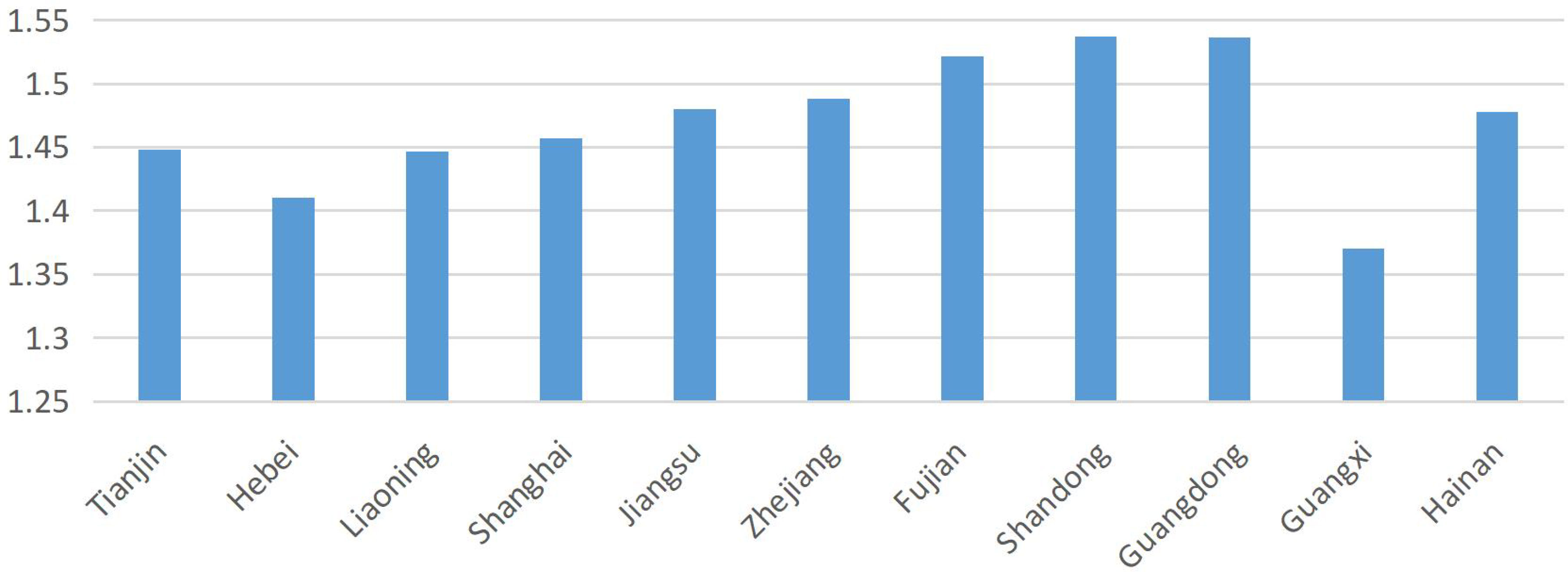
Figure 7 Comparison of the average value of green dimension indicator of high-quality development of marine economy in coastal areas.
According to the results reported in Figure 8, the coordination dimension indicator of high-quality development of marine economy in coastal areas in 2010-2018 was highest in Shandong, with 1.6548, significantly ahead of other provinces, followed by Tianjin, with 1.6173. Hainan was ranked last, with 1.4746. The average value of coordination dimension from 2010 to 2018 was 1.5629, and the coordination dimension indicators of Hainan, Guangxi, Fujian and Guangdong were lower than the average level of coastal areas. Shandong, Tianjin and Liaoning, which ranked the top three, differed from Hainan, which ranked the bottom by 0.1802, 0.1427 and 0.1410, respectively, indicating that the coordination optimization of each province during the sample period had continued to grow while there was a big difference between the provinces with the leading coordination dimension indicator and the backward provinces, and the provinces with relatively low coordination indicators were all in the southern coastal areas. So in the future, the optimization and adjustment of the economic structure in the southern coastal areas will be the main direction to promote the high-quality development of marine economy in this area.
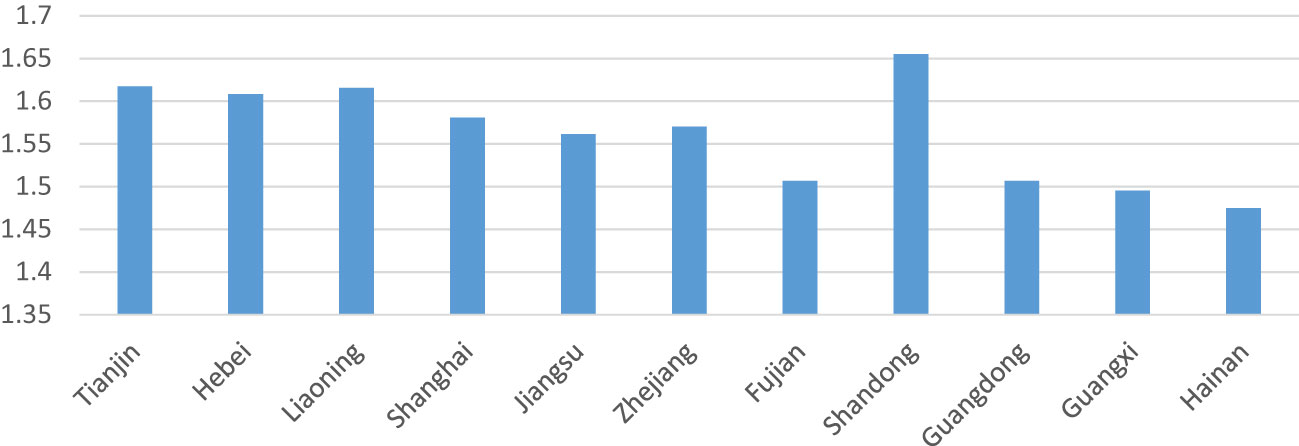
Figure 8 Comparison of the average value of the coordination dimension indicator of high-quality development of marine economy in coastal areas.
According to the results reported in Figure 9, the average score of openness dimension in coastal areas in 2010-2018 was 1.5084, among which the provinces above the average included Shanghai, Shandong, Guangdong, Tianjin, Jiangsu, Zhejiang, Fujian and Liaoning, and only Guangxi, Hainan and Hebei had lower open dimension values than the average, with the lowest score being Guangxi with an openness indicator of 1.3734. The region with the highest score was Shanghai, at 1.5811, indicating that in terms of openness dimension, the differences in most coastal regions were small, and the importance and acting force on marine economic openness in most regions remained relatively unified. However, as far as the score of openness dimension is concerned, the highest score had not yet exceeded 1.6, indicating that there is still room for further development in the degree of openness of the coastal marine economy. All regions should increase the capacity and efficiency of port cargo handling, strengthen close cooperation with foreign enterprises, and strive to promote domestic products to the outside world, so as to gradually increase the international market share and foreign exchange income.
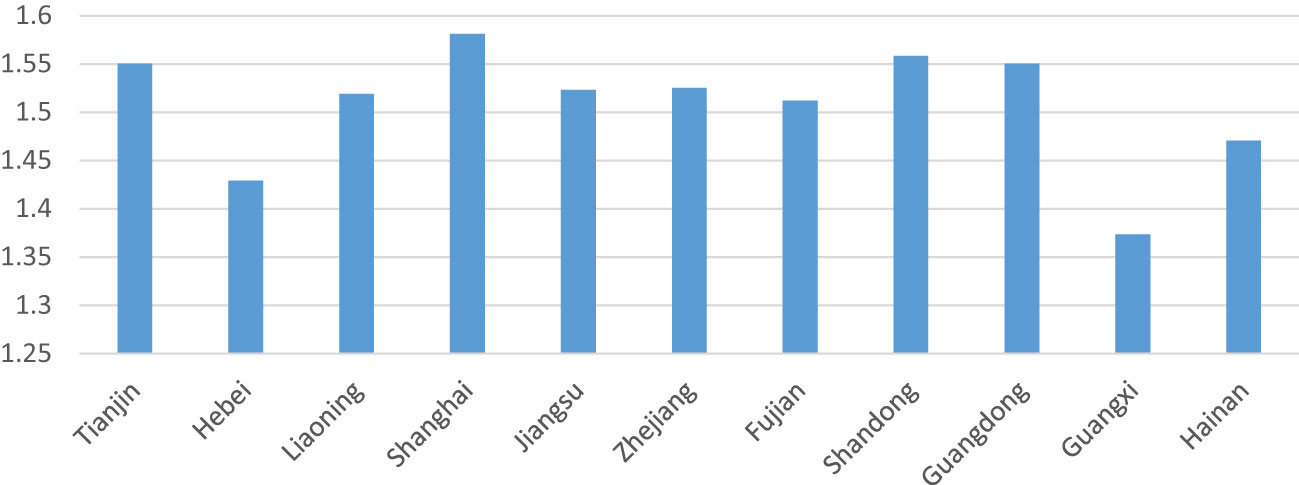
Figure 9 Comparison of the average value of the openness dimension indicator of high-quality development of marine economy in coastal areas.
According to the results reported in Figure 10, the average score of the sharing dimension of high-quality development of marine economy in coastal areas from 2010 to 2018 was 1.4933, and the scores of Shanghai, Jiangsu and Shandong in the sharing dimension were relatively high at 1.5547, 1.5407 and 1.5089 respectively. Except for the above areas, only Guangdong and Zhejiang exceeded the average level of the coastal areas in the sharing dimension, and half of the regions did not touch the average level of sharing. Among them, Guangxi ranked the last in the coastal areas in the sharing dimension score, with 1.4350. It shows that the achievement sharing level of marine economic development in most areas needed to be improved from 2010 to 2018. In the process of improving high-quality development, more attention should be paid to achievement sharing and welfare improvement, so as to improve social security and other livelihood work, improve the quality of public services, and promote regional coordinated development.

Figure 10 Comparison of the average value of the sharing dimension indicator of high-quality development of marine economy in coastal areas.
5 An empirical test on the influence of environmental regulation on the high-quality development of marine economy
5.1 Model building and variable description
5.1.1 Model building
In order to verify the above theoretical hypotheses and fully understand the impact of environmental regulation on the high-quality development of the marine economy, an empirical test model was constructed in this paper from two aspects.
(1) Overall test model
The overall econometric model was constructed according to the theoretical analysis above and the existing related research, as follows:
Where,
hqdme=the high-quality development level of marine economy;
er=the intensity of environmental regulation;
X=a series of control variables;
i =the city;
t =the year;
ϵ =the random error disturbance term.
In order to control the impact of other factors on high-quality development as much as possible, control variables such as infrastructure, government size and information technology were introduced into the model. As the economic development of each region is a process of continuous adjustment, the first-order lag term of the explained variable hqdme was introduced into the measurement model (1) to examine its dynamic change, and the dynamic panel model was constructed as follows:
To verify the possible nonlinear relationship between the overall environmental regulation and the high-quality development of marine economy, the square term of environmental regulation was introduced on the basis of model (2), and the following dynamic panel model was constructed:
Where,
hqdme=the high-quality development level;
er=the intensity of environmental regulation;
X=a series of control variables;
i =the city;
t =the year;
ϵ =the random error disturbance term.
The selection of control variables is consistent with the previous analysis. In order to control the influence of other factors on the high-quality development of marine economy as much as possible, control variables such as informatization, infrastructure and government size were introduced into the model.
(2) Different types of test models
To understand the effects of different types of environmental regulation types, including control type, market incentive type and public participation type, on different dimensions of high-quality development of marine economy, and to fully verify whether the above theoretical hypotheses were valid, the following regression models was constructed in this paper to test:
Where, I.hqdme, G.hqdme, CO.hqdem, O.hqdme and SH.hqdem respectively represent the innovation dimension indicator, green dimension indicator, coordination dimension indicator, openness dimension indicator and sharing dimension indicator of the high-quality development of marine economy; C.er, M.er, S.er represent three kinds of environmental regulation intensity of command type, market incentive type and public participation type respectively. X represents a series of control variables; i represents the city, and t is the year; ϵ represents the random error disturbance term. The selection of control variables is consistent with the above analysis.
5.1.2 Indicator selection and variable description
(1) Indicator selection
The explained variables: The explained variable of overall test was the comprehensive index of high-quality development of marine economy (quality), including innovation dimension indicator (I.hqdme), green dimension indicator (G.hqdme), coordination dimension indicator (CO.hqdem), openness dimension indicator (O.hqdme) and sharing dimension indicator (SH.hqdem), which were calculated by the entropy weight method in the fourth chapter on the comprehensive index of high-quality development of marine economy. This result is basically consistent with previous research results (Wenhan, 2023; Shadbegian, 2005), which further verifies the credibility of the regression results.
Core explanatory variables: The core explanatory variable of the overall test was the intensity of environmental regulation (er), including control type environmental regulation intensity (C.er), market type environmental regulation intensity (M.er) and public type environmental regulation intensity (S.er). which were calculated by entropy weight method. The specific indicator weights and descriptive statistical results are shown in Tables 5 and 6.
Control variables. Based on the existing literature, the control variables selected are as follows:
(1) Infrastructure (infr), measured by total passenger traffic with reference. Infrastructure, as the forerunner and cornerstone of economic development, is an important input to ensure the normal operation of various industrial enterprises. It is conducive to reducing the commuting cost and energy consumption, reducing the flow cost of factors of production between regions, enhancing the production efficiency of enterprises, promoting energy conservation and emission reduction, and thus promoting the quality of development.
(2) Government size (gov), measured by government expenditure on general public services. The government provides public goods and services to the society through fiscal expenditure, which on the one hand drives the development of related industries, increases employment and contributes to economic growth, on the other hand improves the quality of life and promotes the realization of a better life.
(3) Informatization (inf), measured by the total amount of post and telecommunications services. The improvement of informatization level helps to reduce transaction costs, promote the flow and efficient allocation of factor resources, improve the efficiency of technological innovation, the quality and efficiency of economic operation, and promote the improvement of people’s quality of life.
(2) Variable description
Considering the availability and representativeness of the data, the panel data of 11 provinces and cities in coastal areas from 2010 to 2018 were selected as the research object. The basic data were mainly from the China Statistical Yearbook, China Marine Statistical Yearbook, China Fishery Statistical Yearbook, China Environment Yearbook and China City Statistical Yearbook, as well as the research and acquisition of relevant departments of the marine environment.
5.2 Analysis of empirical results
5.2.1 Population regression
(1) Regression results of the influence of environmental regulation on the high-quality development of marine economy
In this paper, the system GMM method was used for estimation. The stepwise regression method was adopted to identify whether the correlation between control variables affects the estimation results of core explanatory variables. As shown in Table 7, the results of AR(2) test and Sargan test show that the model setting is reasonable. Model (1) is an estimation result without any control variables, which indicates that there is an “inverted U” relationship between environmental regulation and the high-quality development of marine economy. Control variables such as infrastructure, government size and informatization were gradually introduced into models (2)-(4). The estimation results show that the estimation coefficients of variables er and er2 were still opposite, which proved that environmental regulation can boost the high-quality development of marine economy under a certain intensity.
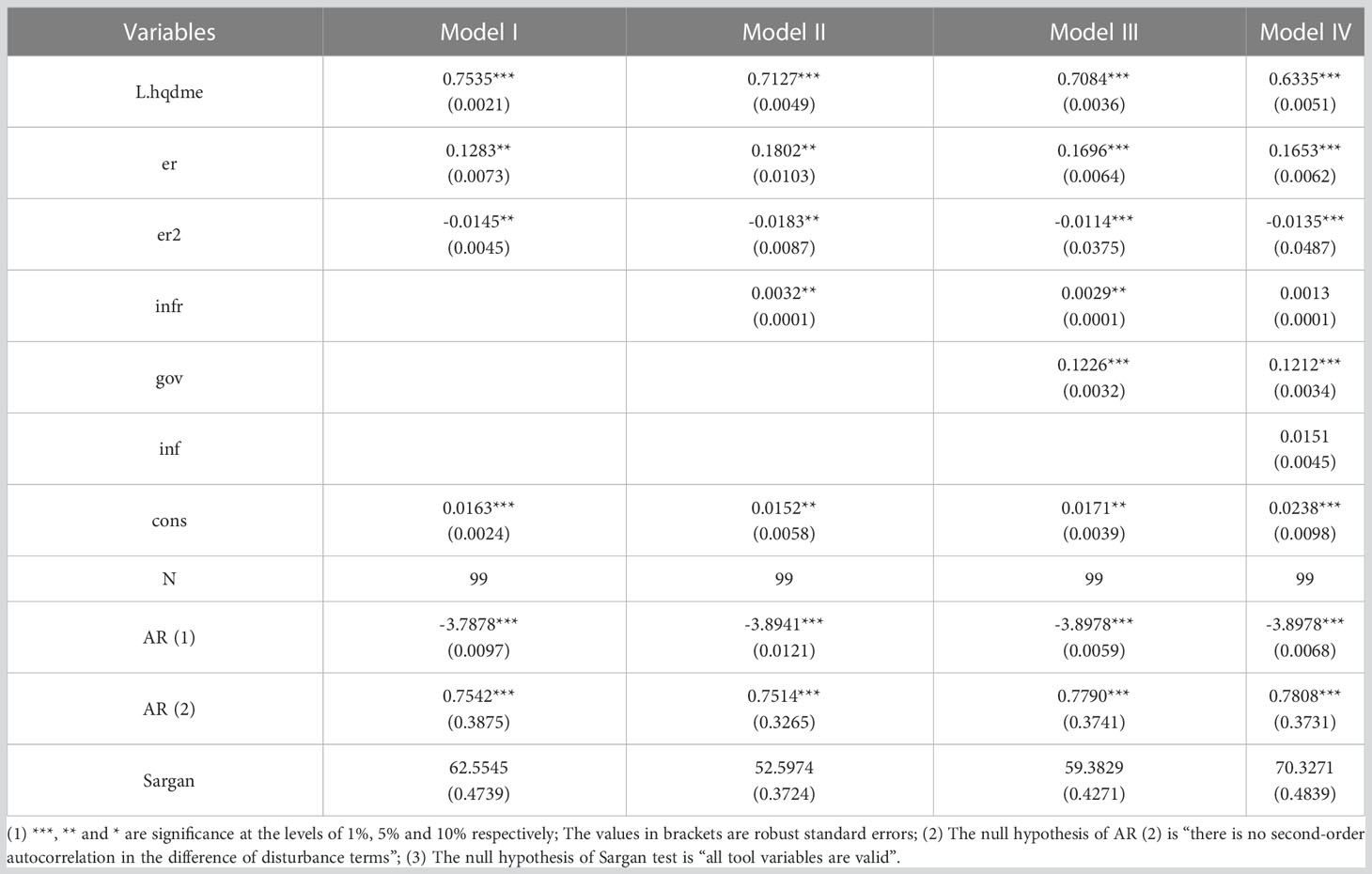
Table 7 Overall estimation results of the influence of environmental regulation intensity on the high-quality development of marine economy.
From the perspective of control variables, the regression coefficient of infrastructure variables is significantly positive, indicating that it can promote the high quality development of marine economy. Infrastructure is an important input to ensure the normal operation of the industrial enterprises, to provide quality production conditions for social production, reduce the flow cost of factors of production between regions, optimize the industrial layout, enhance the market vitality. The estimated coefficient of informatization level is significantly positive, indicating that the promotion of informatization level can effectively reduce transaction costs, promote the free flow of resources and optimize the allocation, and promote economic quality and efficiency. A sound infrastructure is conducive to the reduction of commuting cost and information communication costs, prompting enterprises to reduce transaction costs, speed up technological renewal and progress, and improve economic efficiency. Government size has a positive effect on the high-quality development of marine economy. Local governments’ financial input and environmental supervision play an important role in improving environmental governance and improving the quality of marine economic growth, and drive the green transformation of relevant industries through the adjustment of expenditure structure, improve the social welfare of residents and promote high-quality development. The variable coefficient of informatization is positive but not significant, indicating that the current low level of informatization has not played a boosting role in improving the quality of marine economic development.
(2) Estimation results of environmental regulation on high-quality development of marine economy in various dimensions
Since the indicator construction includes four dimensions: innovation dimension, green dimension, coordination dimension, openness dimension and sharing dimension, the influence of environmental regulation on sub-dimension index was further investigated. Table 8 Model (1) shows that environmental regulation is beneficial to the innovation and development of marine technology at a certain intensity. The innovation dimension mainly includes human capital and technological innovation achievements of scientific research institutions. Human capital and technological innovation are important factors in the innovative dimension of high-quality development of marine economy, so appropriate environmental regulation intensity can promote the promotion of human capital and technological research and development, and finally promote the development of marine technological innovation. When the intensity of environmental regulation reaches a certain level, the resources invested in marine technological innovation can hardly meet the requirements of environmental regulation in a short time, resulting in an increase in innovation load, and the intensity of environmental regulation will have a non-significant inhibitory effect on marine innovation. Model (2) shows that environmental regulation is beneficial to the green development of marine economy. Under the constraints of environmental regulations, high energy consumption and high pollution enterprises are eliminated, prompting enterprises to improve the production process, improve the cleaner production capacity, promote energy conservation and emission reduction, and promote the production efficiency and economic output level of the whole industry through the diffusion of technology. The result of model (3) shows that the appropriate environmental regulation intensity is conducive to promoting the coordinated development of marine industry. A moderate increase in the intensity of environmental regulation can play a role in screening out high pollution industries and backward production capacity, and promote the flow of marine resources to clean industries with higher degree of science and technology, thus reducing the direct pollution caused by fishing and promoting the upgrading of marine industries. The industrial upgrading speed can’t meet the requirements of environmental regulation when the intensity of environmental regulation is too high, which makes some enterprises choose to withdraw from the market, and then leads to the decline of the coordination level of marine economy, that is, the “inverted U” relationship appears. The result of model (4) shows that the appropriate environmental regulation intensity is beneficial to the development of marine economy. The increase in the intensity of environmental regulation can promote the marine enterprises to introduce more efficient and environmentally friendly technologies by strengthening close cooperation with foreign countries. However, excessive intensity of environmental regulation will affect the attraction of domestic marine economic market to foreign markets and make foreign enterprises flinch, thus showing inhibition. The result of model (5) shows that proper environmental regulation is beneficial to the improvement of sharing dimension. The inevitable result of high-quality development of marine economy is to improve quality and efficiency, which is manifested in the improvement of the output efficiency of production factors. Environmental regulations urge enterprises to improve efficiency, reduce energy consumption, improve supply quality, improve the quality of life and happiness of residents, and realize the sharing of development achievements. However, excessive intensity of environmental regulation will affect the output efficiency of factors of production, indirectly affect the income and working hours of residents, and reduce the sharing level.
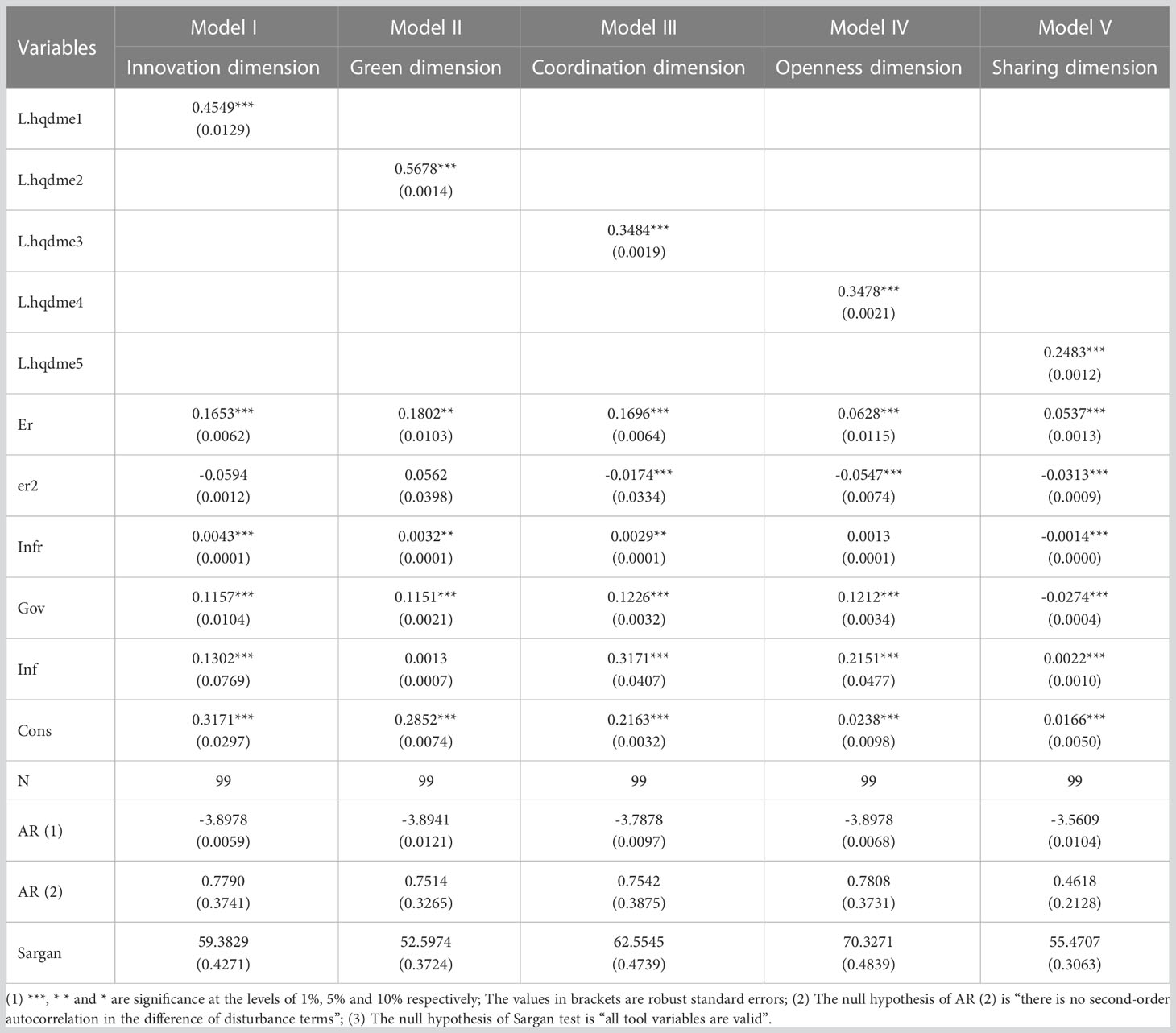
Table 8 Estimation results of environmental regulation intensity on high-quality development of marine economy in various dimensions.
5.2.2 Test based on command type environmental regulation
Table 9 examines the influence of command-control type environmental regulation on the high-quality development of marine economy and its sub-dimensions. The results of models (2), (3) and (4) show that the green dimension, coordination dimension and sharing dimension are significantly positively correlated with the command control type environmental regulation, and the estimation coefficient is higher than other dimensions, which indicates that the command type environmental regulation has a strong role in promoting the development of the green dimension, coordination dimension and sharing dimension of the high-quality development of marine economy. Models (1) and (5) reflect the positive promoting effect of command type environmental regulation on marine economic innovation. Based on the above conclusions, the results shown in model (6) are verified, that is, command type environmental regulations have a positive role in promoting the high-quality development of marine economy, and hypothesis 1 is verified to be true. The marine environmental protection and pollution control are typical public welfare projects, and at present, the local government has been responsible for marine environmental protection in China. The improvement of the central government’s marine environment-related policies and the establishment of diversified performance appraisal mechanisms are conducive to enhancing the willingness of local officials to protect the marine environment. The green performance appraisal system weakens the economic growth rate indicators and brings the environmental protection indicators into the scope of the assessment, which encourages local governments to pay attention to marine environment protection. Under the guidance of marine ecological objectives, the effectiveness of marine environmental pollution control will become a binding indicator of local government performance appraisal. In order to obtain financial resources and political promotion, local governments will pay attention to marine environmental pollution control, strengthen the supply of public services, create and provide a good living environment for the public, and help to improve environmental quality and high-quality development of marine economy.
5.2.3 Test based on market incentive type environmental regulation
The test results of market incentive type environmental regulation are reported in Table 10. In terms of the model results of sub-dimensions, model (1) has the highest coefficient of market incentive type environment regulation, followed by models (3), (4), (2) and (5). At the same time, the market incentive type environmental regulation coefficient in each model is positively correlated with each dimension, that is, market incentive type environmental regulation has a significant role in promoting marine technology innovation, green economy, coordination industrial development, economic opening to the outside world and economic achievement sharing in the high-quality development of marine economy, which is basically consistent with the result of model (6), thus verifying that hypothesis 2 is true, that is, market incentive type environmental regulation has a significant positive role in promoting the innovation dimension of high-quality development of marine economy. With the market- incentive type environmental regulations such as sewage charges and sewage taxes becoming more restrictive, marine enterprises tend to adjust and improve their production and management processes from the source with a view to maximizing long-term profits. By innovating their own production technologies, introducing foreign technologies, and promoting the innovation ability of enterprises, they can reduce pollutant discharge costs, enhance their competitiveness and institutional environment adaptability, and achieve a win-win situation of energy conservation, emission reduction and economic growth. At the same time, market type environmental regulations will promote the overall structural adjustment of the marine industry, improve the coordination level, and indirectly feedback back to the residents’ life and social welfare, thus promoting the high-quality development of the marine economy.
5.2.4 Test based on public participation type environmental regulation
The test results of the influence of public participation type environmental regulation on the high-quality development of marine economy and its sub-dimensions are reported in Table 11. The results of models (1) and (2) show that public environmental regulation has a weak and significant positive promotion effect on the innovation dimension and green dimension of high-quality development of marine economy. The results of models (3) and (4) show that there is no significant weak positive correlation between public environmental regulation, coordination dimension and openness dimension. Model (5) shows that there is a significant positive correlation between public environmental regulation and sharing dimension. Although the test results of models (3) and (4) are not significant, model (6) shows that public environmental regulation has a positive contribution to the high-quality development of marine economy. Based on the above model analysis results, it can be considered that public environmental regulation has a positive role in promoting the high-quality development of marine economy, which basically verifies the hypothesis 3. Since public environmental regulation is interpreted through the public’s enthusiasm for and attention to the environment, and the channels for the public to participate in environmental protection activities are mostly government departments, the impact of public environmental regulation on the high-quality development of marine economy is mostly indirect and to a lesser extent. As the basis of social development, the public is an indispensable and important part of marine economic development. The promotion and feedback relationship between the public and marine economic development forces the marine economy to achieve high-quality development by strengthening the positive interaction with public environmental regulations. To enhance the effect of public environmental regulation on the high-quality development of marine economy, it is necessary to strengthen the connection between government departments and the public, expand communication channels, incorporate public opinions into the government’s environmental performance appraisal mechanism, encourage local governments to speed up the handling of public opinions, and improve the public supervision, so as to promote the high-quality development of marine economy.
5.2.5 Robustness test
To ensure the reliability and stability of the empirical results, in this paper, three indicators of sea area (square kilometers), industrial SO2 discharge (10,000 tons) and domestic garbage removal (10,000 tons) which do not meet the first-class seawater quality standard were added to the three dimensions of the environmental regulation indicator system, and the environmental regulation intensity indicator was reconstructed. At the same time, in order to solve the possible endogenous problem between environmental regulation and the high quality development level of Marine economy, based on the study of Haiqi and Jing (2022), this paper deals with the environmental regulation (er) lagging one stage (L.e), and compares it with the explained variables of the current period. Since the high-quality development of Marine economy in t-1 period will not have an impact on environmental regulation in T-1 period, delayed independent variable regression can solve the endogenous problem caused by two-way causality (Shadbegian and Gray, 2005; Wenhan and Qi, 2023). The regression results are shown in Table 12, basically consistent with the above estimates, thus the empirical results are reliable.
6 Conclusions
Based on the “Five development theories” and the basic types of environmental regulations, this paper makes an empirical analysis on the status quo of high-quality development of Marine economy and the impact of different types of environmental regulations on high-quality development of Marine economy based on previous studies. The main empirical conclusions are as follows:
(1) From 2010 to 2018, China’s Marine economy had a good overall momentum of high-quality development, showing a fluctuating growth trend, and the driving role of innovation dimension played a dominant role in this process.
(2) The status quo of high-quality development of Marine economy in most coastal areas is relatively excellent, showing a spatial difference characteristic of “high in the east and low in the west”. The effect intensity of innovation dimension in all regions is the highest. This result is consistent with the overall evaluation results of high-quality development of Marine economy in China, among which the comprehensive development level of Shandong is better than other regions.
(3) From 2010 to 2018, there was an “inverted U-shaped” relationship between the intensity of environmental regulation and the innovation dimension, coordination dimension, openness dimension and sharing dimension of high-quality development of Marine economy, which had a positive promoting effect on the development of green dimension, that is, appropriate intensity of environmental regulation would have a significant promoting effect on the development of the five dimensions, and then promote the high-quality development of Marine economy. However, when the intensity of environmental regulation is excessive, the development trend of other dimensions will be inhibited except for the continuous improvement of the green dimension, among which the inhibition effect on the innovation and openness dimension is more obvious. From the perspective of different types of environmental regulation, the intensity of command-type environmental regulation has the greatest effect on the quality development of Marine economy. The effect of market-based environmental regulation intensity on each dimension is slightly weaker than that of command-based environmental regulation, but its effect on innovation dimension is stronger than that of command-based environmental regulation intensity. The intensity of public environmental regulation has the lowest effect on all dimensions, but it still has a positive effect on the high-quality development of Marine economy.
7 Discuss
(1) In the process of high-quality development of China’s Marine economy, the innovation of Marine science and technology, the coordinated development of Marine industry and the degree of economic opening to the outside world all play an important positive role in promoting the high-quality development of Marine economy. The positive impact of Marine science and technology innovation on the high-quality development of Marine economy is the most obvious, which reflects that the high-quality development of Marine economy still takes scientific and technological innovation as the core driving force. With the continuous optimization of the macro environment and the increasing degree of opening to the outside world, the scientific and technological content of related products is becoming more prominent. The ability of scientific and technological innovation of relevant enterprises and scientific research institutions is increasing, and the phenomenon conforms to the basic rules and requirements of high-quality development of Marine economy.
(2) Different regions have different perspectives in promoting the high-quality development of Marine economy, and there is no region with outstanding “five dimensions”. It should be noted that the “green dimension”, as the dimension most closely related to the environment, is currently the focus of the high-quality development of Marine economy, and is also an evaluation dimension with less influence on regional endowments. However, it has not yet reached the high-level development status of the whole region. It is reflected that some sea-related enterprises still attach importance to “green development” in some areas and still need to be strengthened further.
(3) Among the “five dimensions”, the contribution of green dimension and shared dimension to high-quality development of Marine economy is lower than the other three dimensions, which further explains the defects of high-quality development of Marine economy at the present stage. This will also become the new point and breakthrough of the high-quality development of our Marine economy in the future. At the same time, combined with the fact that there is an “inverted U” relationship between environmental regulation and high-quality development of Marine economy in the empirical results, it is proved that the relationship between environmental regulation and high-quality development of Marine economy is close to an inflection point. Comprehensively considering that in the model measurement, the effect of command type environmental regulation on the high-quality development of Marine economy is the largest, while the effect of public type environmental regulation is the weakest. This paper believes that the main reason for the inflection point is that the difference of the effect intensity of three types of environmental regulation on the high-quality development of Marine economy is too large. In particular, although public environmental regulation plays a positive role in promoting the high-quality development of Marine economy, it is in a weak position, which is significantly correlated with the weak degree of sharing dimension.
8 Policy recommendations
(1) Standardize government behavior and strengthen marine environmental governance and marine supervision and management
Marine environmental governance has the characteristics of public goods, and local governments play an important role in the conservation and efficient utilization of marine resources and the promotion of marine ecological environment governance and protection, such as encouraging local governments to fulfill their marine environmental responsibility and strengthening investment in marine environmental protection by improving regulatory measures.
First, the local government’s investment preference should be adjusted to formulate a targeted plan suitable for the development of the local marine economy based on the local marine resources endowment, regional marine advantages and marine economic conditions. Investment in marine environmental pollution control should be increased to realize the green transformation of coastal areas. The support for marine environmental protection industry should be strengthened, the investment in science and technology and marine environmental protection should be increased, the cleaner production capacity of marine enterprises should be improved, and marine enterprises should be urged to reduce marine pollution discharge from the source, reduce marine environmental pollution, and improve the high-quality development level of marine economy.
Second, local government competition should be standardized, marine environmental protection and other assessment indicators should be introduced into the assessment system of local officials, and a performance assessment system oriented towards high-quality development of the marine economy should be established and improved. The pursuit of quantitative growth should be changed to improve the quality of marine economic development, and the improvement of the marine environment and high-quality development of the marine economy should be promoted by standardizing and adjusting the behavior of local governments. As the local government is the core force to improve the quality of marine economic development, it is necessary to improve the marine regulatory policies, regulate the tax competition behavior of the local government, avoid the marine resources mismatch problem caused by malignant competition, promote the efficient use of marine resources, and promote the optimization of the marine industrial structure. Marine environmental governance needs the coordinated promotion of coastal areas, because the adjacent marine environmental pollution will affect the local marine environmental conditions. It is necessary to build a cooperative mechanism for marine environmental pollution governance, avoid hitchhiking, and increase the penalties for major marine environmental pollution incidents.
Third, the intensity of resources development in marine ecological function zones should be limited and the control targets of marine pollution emissions should be strictly determined. Efforts should be made to support the development of efficient and clean marine energy technologies, accelerate the pace of scientific and technological innovation of marine enterprises through government subsidies for marine environmental protection, strengthen the cooperation in technological research and development between marine enterprises and scientific research institutions, promote the application of marine energy-saving and environmental protection technologies, update marine environmental protection facilities, and urge marine enterprises to control marine pollution emissions from the source.
Fourthly, in the strategic plan for high-quality development of the marine economy, financial subsidies and tax incentives should be adopted to support the construction of marine environmental protection infrastructure, implement the responsibility system for paid use of marine resources, accelerate the construction of a marine resource-saving society, and realize high-quality development of the marine economy. The intensity of environmental regulation should be strengthened, the market entry threshold should be raised, backward production capacity should be eliminated, and the non-standard marine enterprises should be ordered to close down. The local government should establish a supervision mechanism for environmental regulation of enterprises involved in the sea, increase the illegal cost of marine pollution, and strengthen the accountability of marine pollution.
(2) The marine enterprises should be encouraged to invest in technological innovation and marine environmental protection, because technological innovation to achieve energy conservation and emission reduction and marine environment improvement is the power source for the high-quality development of the marine economy, and the marine power conversion should be promoted through technological innovation. First, the government should increase subsidies for research and development of clean technologies, guide marine enterprises to use clean energy, improve green production processes and change the behavior of end-of-life governance of marine enterprises by means of tax incentives and financial subsidies, and urge marine enterprises to use clean production technologies throughout the production process, which will help reduce energy consumption and improve green total factor productivity of the marine industry. Green marine production technology should be applied to provide high-quality marine ecological products to promote high-quality development of marine economy. Second, green technology talents should be actively cultivated, and talents, funds and policies for research and development of key technologies for the green transformation of traditional marine industries should be increased, so as to improve the quality of human capital and research and development of green marine ecological technologies. The allocation of marine resources and elements should be integrated, and marine enterprises with heavy marine pollution should be resolutely banned, so as to promote the flow of marine production elements to clean industries with high technical level and good marine environmental benefits, promote the optimization of marine industrial structure, and promote energy conservation and emission reduction. Third, environmental regulations should be improved to raise the market access threshold, the negative externalities of environmental pollution of marine enterprises should be internalized into environmental costs, effective constraints should be formed on the production and operation decisions of marine enterprises, marine enterprises should be promoted to expand investment in environmental protection, so as to increase the construction expenditure of marine environmental protection projects, update marine environmental protection equipment, actively use clean energy, improve production efficiency, eliminate backward production capacity, speed up the technological transformation of marine environmental protection, promote marine enterprises to adopt green processes, realize cleaner production, promote the widespread use of green packaging, reduce energy consumption, provide low-carbon environmental protection products through cleaner production, and improve supply quality. Fourthly, low-carbon marine environmental protection industries should be developed and strengthened. Through the integration of marine secondary and tertiary industries, marine green technology progress should be promoted, marine industrial chains should be expanded and marine value chains should be upgraded so as to realize the parallel development of marine ecological environment protection and high-quality marine economy. Through environmental regulation, marine emission standards and technical standards should be improved, and technological innovation should be forced for marine-related enterprises. The utilization efficiency of marine resources should be improved, cleaner production should be realized and marine environment should be improved, which is conducive to high-quality development of marine economy.
(3) Guide public participation in environmental protection and encourage green consumption.
A better life needs to inspire the public (the biggest stakeholders of the marine environment) to appeal for environmental protection, and the increasing intensity of environmental regulation urges the public to pay more attention to and attach importance to marine environmental protection. Firstly, the public participation mechanism should be improved. At the present stage, the public participation in environmental protection helps the government to strengthen the supervision of the marine environment and improve the quality of the marine environment. The enthusiasm and initiative of the public to participate in marine environmental governance and protection should be effectively improved by means of various publicity channels and online media, so as to form a supervisory effect on the government’s marine environmental law enforcement and marine-related enterprises’ pollution discharge, and the information disclosure system should be improved to reduce the cost of public participation. Government environmental protection departments at all levels should actively publicize environmental contents such as marine environmental policies, marine environmental standards, marine environmental quality, etc. through online media, newspapers, etc., so as to give full play to the public’s role in supervising the pollution discharge behavior of enterprises involved in the sea. Second, the publicity and education of marine environmental protection knowledge should be strengthened. The government should actively introduce laws and regulations to regulate the market of green marine products, set up green marine product standards and certification mechanism, and improve the public awareness of environmental protection through education and publicity. Third, green consumption should be guided to promote the green transformation of lifestyle and resist excessive and extravagant consumption. Green consumption demand can promote technological innovation and transformation of production methods of sea-related enterprises, and promote the improvement of the marine environment. Marine environmental protection education should be promoted in schools, communities and institutions, so as to improve citizens’ awareness of marine environmental protection, turn scientific environmental protection measures into citizens’ conscious actions. The green lifestyle should be advocated, environmental protection products should be popularized, and marine resources should be used sparingly, so as to reduce marine pollution and jointly build beautiful homeland.
Data availability statement
The original contributions presented in the study are included in the article. Further inquiries can be directed to the corresponding author.
Author contributions
Conception and design were performed by TL and FW. Material preparation, data collection, and analysis were performed by TL and FC. The first draft of the manuscript was written by FC. All authors contributed to the article and approved the submitted version.
Conflict of interest
The authors declare that the research was conducted in the absence of any commercial or financial relationships that could be construed as a potential conflict of interest.
Publisher’s note
All claims expressed in this article are solely those of the authors and do not necessarily represent those of their affiliated organizations, or those of the publisher, the editors and the reviewers. Any product that may be evaluated in this article, or claim that may be made by its manufacturer, is not guaranteed or endorsed by the publisher.
References
Asian Games, Feng Y., Xingyun Li (2019). Study on the construction and application of the high-quality development evaluation index system of marine economy in our country from the perspective of five development concepts. Enterprise. Econ. 38 (12), 122–130.
Haiqi L., Jing Z. (2022). The influence of financial technology on industrial structure optimization and industrial upgrading. Stat. Res. 39 (10), 102–118.
Hui Z., Wenliang Z., Jingling Z., Zhiwei N. (2020). Study on the connotation and index system of high-quality development of marine economy in tianjin. China’s. Land. Resour. Econ. 33 (06), 34–42.
Jamnia A. R., Mazloumzadeh S. M., Keikha A. A. (2015). Estimate the technical efficiency of fishing vessels operating in chabahar region,Southern Iran. J. Saudi. Soc. Agric. Sci. 14 (1), 5–17. doi: 10.1016/j.jssas.2013.04.005
Jian C. (2021). The impact of environmental regulation on the green development of marine economy. Tech. Econ. Manage. Res. 12), 103–107.
Jing N., Yaqian R., Gang W., Lan W. (2022). How does environmental regulation affect the efficiency of the marine industry? based on the co-moderating effect of science and technology innovation and FDI. Sci. Technol. Manage. Res. 42 (03), 214–223.
Marques J. C., Basset A., Brey T., Elliott M. (2009). The ecological sustainability trigon-a proposed conceptual framework for creating and testing management scenarios. Mar. pollut. Bull. 58, 1773–1779. doi: 10.1016/j.marpolbul.2009.08.020
Martinez M. L., Intralawana, Vazquez G. (2006). The coasts of our world:Ecological economic and social importance. Ecol. Econ. 63 (2), 6–13.
Mlachila M., Tapsoba R., Tapsoba S. J. A. (2014). A quality of growth index for developing countries: a proposal Vol. 172 (IMF Working Paper).
Ruiheng X., Xinyue L. (2020). Multi-compensation subject, environmental regulation and sustainable development of marine economy. Econ. Questions. 11), 58–67.
Shadbegian R. J., Gray W. B. (2005). Pollution abatement wxpenditures and plant-level productivity: a production function approach. Ecol. Econ. 54 (2-3), 196–208. doi: 10.1016/j.ecolecon.2004.12.029
Smith-Godfrey S. (2016). Defining the blue economy. Maritime. Affairs.: J. Natl. Maritime. Foundation. India. 12 (1), 33–42.
Tingley D., Pascoe S., Coglan L. (2005). Factors affecting technical efficiency in fisheries: stochastic production frontier versus data envelopment analysis approaches. Fisheries. Res. 73 (3), 76–87.
Tridico P. (2010). Growth, inequality and poverty in emerging and transition economies. Transition. Stud. Rev. 16 (4), 89–99.
Wang Z., Zhang B., Zeng H. (2016). The effect of environmental regulation on external trade: empirical evidences from Chinese economy. J. Cleaner. Production. 114, 55–561. doi: 10.1016/j.jclepro.2015.07.148
Wenhan R., Qi W. (2023). Impact of environmental regulation on green technology progress of marine economy. Sci. Res. Manage. 44 (02), 55–64.
Xiaomei X., Chao Z. (2020). Study on high-quality coordinated development path of marine economy in guangdong-hong Kong-macao bay area. Asia-pacific. Economies. 02), 142–148 + 152.
Yuan F., Li X., Lu Y. (2020). Analysis of high-quality development of marine economy in guangdong-hong Kong-macao bay area. Cooperative. Econ. Technol. 15), 4–6.
Yumin Z., Fangming Z., Lilong H. (2009). Study on the definition, classification and evolution of environmental regulation. China’s. Population. Resour. Environ. 19 (6), 85–90.
Zenglin H., Bo Li, mingbao C., Dahai L. (2019). High-quality development of marine economy. J. Ocean. Univ. China Sci. (Social. Sciences). 05), 13–21.
Keywords: environmental regulation, high-quality development of marine economy, main body, marine economy, environmental
Citation: Wu F, Cui F and Liu T (2023) The influence of environmental regulation on high-quality development of marine economy from different subjects’ perspectives. Front. Mar. Sci. 10:1107666. doi: 10.3389/fmars.2023.1107666
Received: 07 February 2023; Accepted: 22 May 2023;
Published: 15 June 2023.
Edited by:
Yen-Chiang Chang, Dalian Maritime University, ChinaCopyright © 2023 Wu, Cui and Liu. This is an open-access article distributed under the terms of the Creative Commons Attribution License (CC BY). The use, distribution or reproduction in other forums is permitted, provided the original author(s) and the copyright owner(s) are credited and that the original publication in this journal is cited, in accordance with accepted academic practice. No use, distribution or reproduction is permitted which does not comply with these terms.
*Correspondence: Tao Liu, c2tkOTk2NDA0QHNkdXN0LmVkdS5jbg==
 Fan Wu
Fan Wu Fengxiang Cui1
Fengxiang Cui1